Paul van Yperen's Blog, page 423
April 6, 2014
Diomira Jacobini
Diomira Jacobini (1899-1959) was one of the stars of the Italian silent cinema. She was the younger sister of film diva Maria Jacobini, in whose shadow she always stayed. Diomira appeared in some 55 films in Italy, Germany and Denmark.
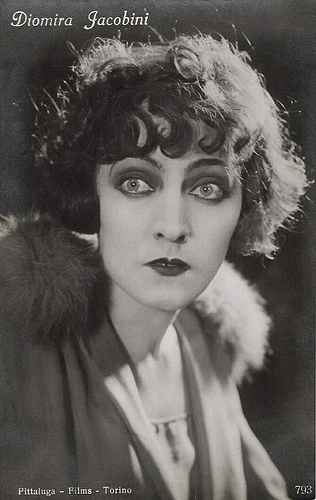
Italian postcard by Ed. A. Traldi, Milano, no. 793. Photo: Pittaluga-Films, Torino (Turin).
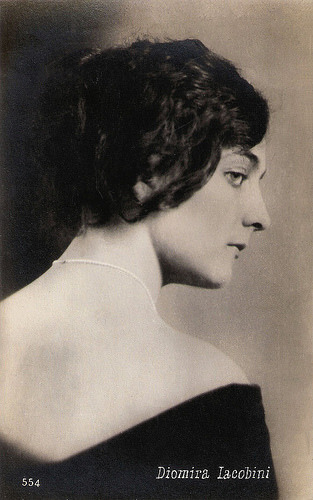
Italian postcard by Ed. Ballerini & Fratini, Firenze, no. 554.
A Scandal in the Noble Family
Diomira Jacobini was born in Rome, Italy in 1896. She was the niece of a Vatican-based cardinal.
When her older sister, Maria Jacobini , chose to work as an actress in the young film industry, it caused a scandal in the noble family.
The young Diomira decided to follow in her sister’s footsteps. She started to work for the prestigious Cines film studio in Rome. There she first appeared in such short films as Anna Maria/For Her Father's Sake (1912) with Ida Carloni Talli.
Her name was included in the title when she appeared in the short comedy Le birichinate di Kri Kri e Diomira/Bloomer and Diomira at Play (1913) featuring Raymond Dandy, whose comic character Kri Kri was very popular at the time.
According to Wikipedia , Jacobini had her first starring role in Il piccolo mozzo/The small hub (Carmine Gallone, 1915).
In the same year she participated next to Lyda Borelli in Marcia nuziale/Wedding March (Carmine Gallone, 1915) in which she had one of her finest and prettiest parts.
For the Celio film company, she co-starred with her sister Maria and another diva, Leda Gys in Ananka/Fate (1915), directed by Maria’s fiancé Nino Oxilia.
In 1916, she moved on to Tiber Film. For the Tiber studio Jacobini made many films. Under the direction of Emilio Ghione , she made La rosa di granata/The Rose of Granada (Emilio Ghione, 1916) with Ida Carloni Talli and Lina Cavalieri , Tormento gentile/Kind Torment (Emilio Ghione, 1916) with Alda Borelli , Il figlio dell'amore/The Love Child (Emilio Ghione, 1916).
A success was Demonietto/Imp (Gennaro Righelli, 1917). The male lead of this film was played by Alberto Collo , who would also be her co-star in several other films.
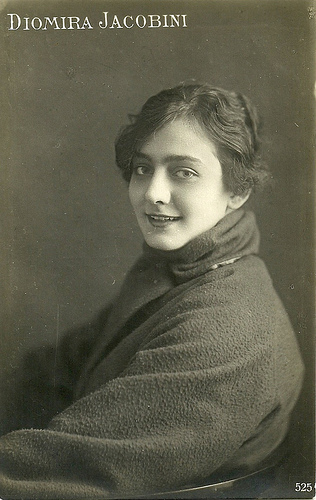
Italian postcard by Ed. A. Traldi, Milano, no. 525.
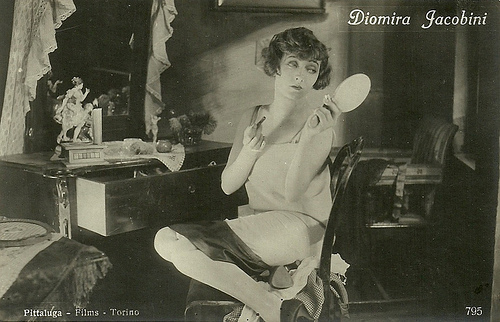
Italian postcard by Ed. Traldi, Milano, no. 795. Photo: Pittaluga Films, Torino.
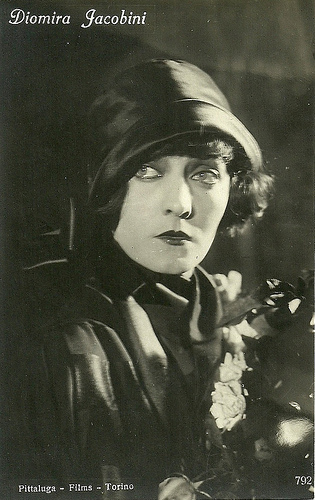
Italian postcard by Ed. A. Traldi, Milano, no. 792. Photo: Pitaluga-Films, Torino.
A Deep Crisis
After finishing her engagement at Tiber Film, Diomira Jacobini signed a contract with Fert Film.
The 1920s were less satisfactory for the actress, although she could show her talents successfully in films like La rosa di Fortunio/The Rose of Fortunio (Luciano Doria, 1922), Jolly, clown da circo/Jolly, circus clown (Mario Camerini, 1923) and La casa dei pulcini/The House of Pulcini (Mario Camerini, 1924) with Amleto Novelli .
She also starred opposite the popular ‘forzuto’ (strongman) Bartolomeo Pagano in the action film Maciste e il nipote d'America/Maciste and the nephew from America (Eleuterio Rodolfi, 1924).
At that time, the Italian film industry was in a deep crisis and only a few films were produced. Some of the best film actors and directors went to work abroad. Maria Jacobini was already working in Germany.
There, Diomira co-starred with Werner Krauss in Der Trödler von Amsterdam/The junk dealer of Amsterdam (Victor Janson, 1925) and in some other films.
In Denmark she appeared in Revolutionsbryllup/The Last Night (A.W. Sandberg, 1927) opposite Gösta Ekman .
In the 1930s, she returned to Italy, and worked again at Cines, where she acted in Il buon ragazzo/The good boy (Mario Camerini, 1930).
She made only two sound films: L'ultima avventura/The Last Adventure (Mario Camerini, 1932) starring Armando Falconi , and Cento di questi giorni/Hundred of these days (Augusto and Mario Camerini, 1933).
Then she retired to private life with her husband L. Ghezzi. However, she participated in Quando eravamo muti/When we were silent (Riccardo Cassano, 1935).
Diomira Jacobini died in 1959 in Rome.
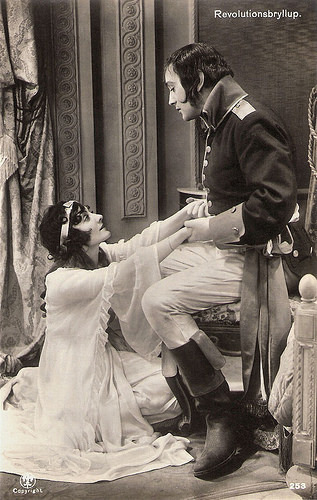
Danish postcard by Alex. Vincent's Kunstforlag, Eneret, no. 253. Photo: publicity still for Revolutionsbryllup/The Last Night (A.W. Sandberg, 1927) with Gösta Ekman .
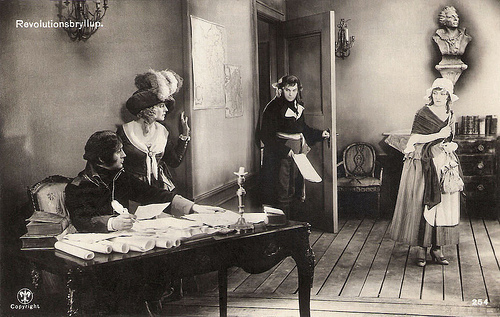
Danish postcard by Alex. Vincent's Kunstforlag, Eneret, no. 254. Photo: publicity still for Revolutionsbryllup/The Last Night (A.W. Sandberg, 1927). This was a German-Danish dramatization of Sophus Michaëlis' play Revolutionshochzeit (Revolutionary Wedding), with also Gösta Ekman , Karina Bell , Walter Rilla and Fritz Kortner , and produced by Terra-Filmkunst.
Sources: Treccani.it (Italian), Wikipedia (Italian), and .

Italian postcard by Ed. A. Traldi, Milano, no. 793. Photo: Pittaluga-Films, Torino (Turin).

Italian postcard by Ed. Ballerini & Fratini, Firenze, no. 554.
A Scandal in the Noble Family
Diomira Jacobini was born in Rome, Italy in 1896. She was the niece of a Vatican-based cardinal.
When her older sister, Maria Jacobini , chose to work as an actress in the young film industry, it caused a scandal in the noble family.
The young Diomira decided to follow in her sister’s footsteps. She started to work for the prestigious Cines film studio in Rome. There she first appeared in such short films as Anna Maria/For Her Father's Sake (1912) with Ida Carloni Talli.
Her name was included in the title when she appeared in the short comedy Le birichinate di Kri Kri e Diomira/Bloomer and Diomira at Play (1913) featuring Raymond Dandy, whose comic character Kri Kri was very popular at the time.
According to Wikipedia , Jacobini had her first starring role in Il piccolo mozzo/The small hub (Carmine Gallone, 1915).
In the same year she participated next to Lyda Borelli in Marcia nuziale/Wedding March (Carmine Gallone, 1915) in which she had one of her finest and prettiest parts.
For the Celio film company, she co-starred with her sister Maria and another diva, Leda Gys in Ananka/Fate (1915), directed by Maria’s fiancé Nino Oxilia.
In 1916, she moved on to Tiber Film. For the Tiber studio Jacobini made many films. Under the direction of Emilio Ghione , she made La rosa di granata/The Rose of Granada (Emilio Ghione, 1916) with Ida Carloni Talli and Lina Cavalieri , Tormento gentile/Kind Torment (Emilio Ghione, 1916) with Alda Borelli , Il figlio dell'amore/The Love Child (Emilio Ghione, 1916).
A success was Demonietto/Imp (Gennaro Righelli, 1917). The male lead of this film was played by Alberto Collo , who would also be her co-star in several other films.

Italian postcard by Ed. A. Traldi, Milano, no. 525.

Italian postcard by Ed. Traldi, Milano, no. 795. Photo: Pittaluga Films, Torino.

Italian postcard by Ed. A. Traldi, Milano, no. 792. Photo: Pitaluga-Films, Torino.
A Deep Crisis
After finishing her engagement at Tiber Film, Diomira Jacobini signed a contract with Fert Film.
The 1920s were less satisfactory for the actress, although she could show her talents successfully in films like La rosa di Fortunio/The Rose of Fortunio (Luciano Doria, 1922), Jolly, clown da circo/Jolly, circus clown (Mario Camerini, 1923) and La casa dei pulcini/The House of Pulcini (Mario Camerini, 1924) with Amleto Novelli .
She also starred opposite the popular ‘forzuto’ (strongman) Bartolomeo Pagano in the action film Maciste e il nipote d'America/Maciste and the nephew from America (Eleuterio Rodolfi, 1924).
At that time, the Italian film industry was in a deep crisis and only a few films were produced. Some of the best film actors and directors went to work abroad. Maria Jacobini was already working in Germany.
There, Diomira co-starred with Werner Krauss in Der Trödler von Amsterdam/The junk dealer of Amsterdam (Victor Janson, 1925) and in some other films.
In Denmark she appeared in Revolutionsbryllup/The Last Night (A.W. Sandberg, 1927) opposite Gösta Ekman .
In the 1930s, she returned to Italy, and worked again at Cines, where she acted in Il buon ragazzo/The good boy (Mario Camerini, 1930).
She made only two sound films: L'ultima avventura/The Last Adventure (Mario Camerini, 1932) starring Armando Falconi , and Cento di questi giorni/Hundred of these days (Augusto and Mario Camerini, 1933).
Then she retired to private life with her husband L. Ghezzi. However, she participated in Quando eravamo muti/When we were silent (Riccardo Cassano, 1935).
Diomira Jacobini died in 1959 in Rome.

Danish postcard by Alex. Vincent's Kunstforlag, Eneret, no. 253. Photo: publicity still for Revolutionsbryllup/The Last Night (A.W. Sandberg, 1927) with Gösta Ekman .

Danish postcard by Alex. Vincent's Kunstforlag, Eneret, no. 254. Photo: publicity still for Revolutionsbryllup/The Last Night (A.W. Sandberg, 1927). This was a German-Danish dramatization of Sophus Michaëlis' play Revolutionshochzeit (Revolutionary Wedding), with also Gösta Ekman , Karina Bell , Walter Rilla and Fritz Kortner , and produced by Terra-Filmkunst.
Sources: Treccani.it (Italian), Wikipedia (Italian), and .
Published on April 06, 2014 23:00
April 5, 2014
Rudolf Klein-Rogge
Rudolf Klein-Rogge (1888-1955) is best remembered for his sinister roles in Fritz Lang's silent masterpieces. He played the devilish hypnotist Mabuse in Dr. Mabuse, der Spieler (1925) and the mad scientist Rotwang in Metropolis (1927), but he played more parts in classics of the German cinema.
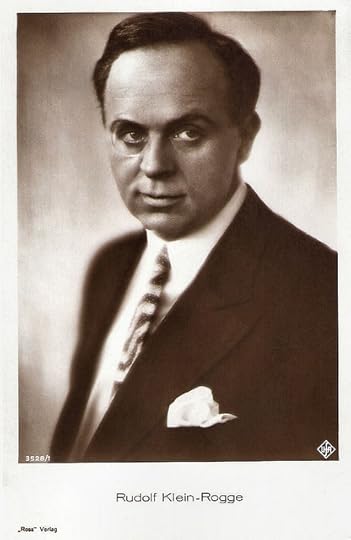
German postcard by Ross Verlag no. 3528/1, 1928-1929. Photo: Ufa.
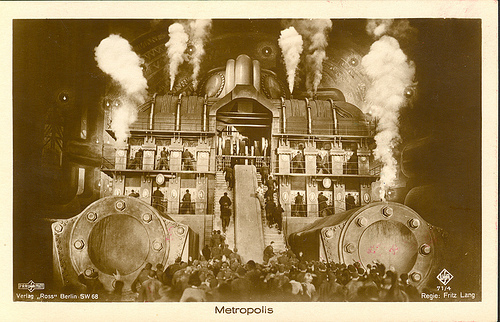
German postcard by Ross Verlag, Berlin, no. 71-4. Photo: Ufa / Parufamet. Publicity still for Metropolis (Fritz Lang, 1927). Collection: Amsterdam EYE Filmmuseum.
Intense Stare
Friedrich Rudolf Klein-Rogge was born in Cologne, Germany, in 1888.
He took acting lessons while studying art history and made his acting debut in 1909. While playing in the city of Aachen, he met actress/screenwriter Thea von Harbou and married her.
In 1913 he made his debut as a film actor in Der Film von der Konigin Luise/The film of Queen Luise (Franz Porten, 1913), but he returned to stage acting. It took more than five years before film acting really became his profession.
In 1915 he moved to Nurnberg (Nuremberg), where he became a star of the Nuremberg Stadttheater.
Even if he had quite a good salary with 12,000 Deutsch Mark a year, his wife earned much more with her novels. She could even earn more in Berlin, so they moved to the capital.
In Berlin, Klein-Rogge continued his stage career at the Lessing Theater, but that proved to be tougher as told and his stage career came to a halt.
After several minor films and a bit part in the expressionist classic Das Cabinet des Dr. Caligari/The Cabinet of Dr. Caligari (Robert Wiene, 1920), Klein-Rogge played his first part with Fritz Lang in his film Das wandernde Bild/The Wandering Image (1920) starring Mia May .
The script was written by Thea Von Harbou, who had an affair with Lang. She eventually divorced Klein-Rogge and became Lang's wife. Von Harbau and Klein-Rogge remained friends.
Klein-Rogge would perform great roles in many films directed by Lang and written by Von Harbou, such as the Derwish/Girolamo in Der müde Tod/Destiny (1921), the devilish title character in Dr. Mabuse, der Spieler/Dr. Mabuse, the Gambler (1922), king Etzel in Die Nibelungen (1924), the mad scientist Rotwang in Metropolis (1927), and Haghi in Spione/Spies (1928).
Reportedly, Paul Richter (Siegfried) did not dare to show his bare back in Die Nibelungen when Siegfried takes his bath in the blood of the dragon, so Klein-Rogge doubled him in this scene.
His intense stare became well-known because of his part as the criminal hypnotist Mabuse. The success of the film delivered him similar roles, such as the tyrant in Der steinerne Reiter/The Stone Rider (Fritz Wendhause, 1923), the pirate in Pietro der Korsar/Peter the Pirate (Arthur Robinson, 1925), and the Czar in Casanova (Alexandre Volkoff, 1927) starring Ivan Mozzhukhin .
Klein-Rogge's last film with Lang was the sequel Das Testament des Dr. Mabuse/The Testament of Dr. Mabuse (Fritz Lang, 1932).
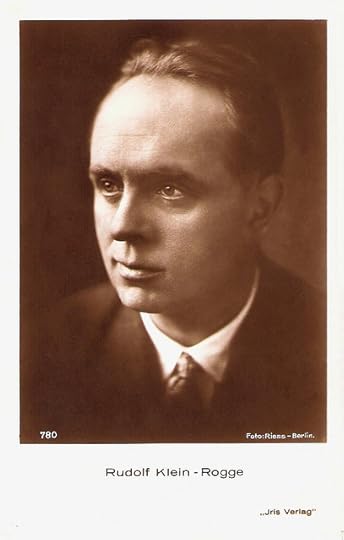
Austrian postcard by Iris Verlag no. 780. Photo: Riess, Berlin.
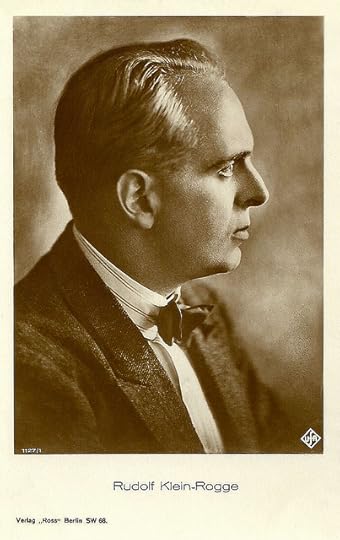
German postcard by Ross Verlag, Berlin, no. 1127/1, 1927-1928. Photo: Ufa.
Type casted
Next to Casanova, Rudolf Klein-Rogge played in a number of international co-productions in the late 1920s including the British-German co-production The Queen was in the Parlour (Graham Cutts, 1927).
He also appeared in the French films La faute de Monique/Monique's Fault (Maurice Gleize, 1928), Tu m'appartiens!/You Belong to Me (Maurice Gleize, 1929) with Francesca Bertini , La maison des hommes vivants/The House of the Living Men (Marcel Dumont, Gaston Roudès, 1929), the first French full sound film Le requin/The Shark (Henri Chomette, 1929), and the part-talkie Tarakanova (Raymond Bernard, 1930) starring Édith Jéhanne .
In 1930 he also played in the Danish/Norwegian film Eskimo (George Schneevogt, 1930) and two years later in the German version of the film too, just like he also played in the French version Le testament du Dr. Mabuse/The Last Will of Dr. Mabuse (Fritz Lang, René Sti, 1933) of Lang's final film in Weimar Germany.
During the 1930s, Klein-Rogge continued to play in the German sound cinema. He was often type casted just like in the old days of the silent cinema.
Only rarely he played comic roles. His last part was in Hochzeit auf dem Bärenhof/Wedding at the Bärenhof Carl Froehlich, 1942) starring Heinrich George .
Rudolf Klein-Rogge died in Wetzelsdorf, Austria, in 1955. He had been married three times: first to Thea von Harbou (1914-1921); then to Margarethe Neff (until 1932); and finally to Swedish actress Mary Johnson (in 1932) who remained with him till his death. With Johnson he had one child.
Scene from Dr. Mabuse, der Spieler (1922). Source: Le Cercle Vicieux (YouTube).
Beginning sequence of Spione/Spies (1928). Source: Manferot (YouTube).
Sources: Thomas Schaedeli (Cyranos), Wikipedia, and .

German postcard by Ross Verlag no. 3528/1, 1928-1929. Photo: Ufa.

German postcard by Ross Verlag, Berlin, no. 71-4. Photo: Ufa / Parufamet. Publicity still for Metropolis (Fritz Lang, 1927). Collection: Amsterdam EYE Filmmuseum.
Intense Stare
Friedrich Rudolf Klein-Rogge was born in Cologne, Germany, in 1888.
He took acting lessons while studying art history and made his acting debut in 1909. While playing in the city of Aachen, he met actress/screenwriter Thea von Harbou and married her.
In 1913 he made his debut as a film actor in Der Film von der Konigin Luise/The film of Queen Luise (Franz Porten, 1913), but he returned to stage acting. It took more than five years before film acting really became his profession.
In 1915 he moved to Nurnberg (Nuremberg), where he became a star of the Nuremberg Stadttheater.
Even if he had quite a good salary with 12,000 Deutsch Mark a year, his wife earned much more with her novels. She could even earn more in Berlin, so they moved to the capital.
In Berlin, Klein-Rogge continued his stage career at the Lessing Theater, but that proved to be tougher as told and his stage career came to a halt.
After several minor films and a bit part in the expressionist classic Das Cabinet des Dr. Caligari/The Cabinet of Dr. Caligari (Robert Wiene, 1920), Klein-Rogge played his first part with Fritz Lang in his film Das wandernde Bild/The Wandering Image (1920) starring Mia May .
The script was written by Thea Von Harbou, who had an affair with Lang. She eventually divorced Klein-Rogge and became Lang's wife. Von Harbau and Klein-Rogge remained friends.
Klein-Rogge would perform great roles in many films directed by Lang and written by Von Harbou, such as the Derwish/Girolamo in Der müde Tod/Destiny (1921), the devilish title character in Dr. Mabuse, der Spieler/Dr. Mabuse, the Gambler (1922), king Etzel in Die Nibelungen (1924), the mad scientist Rotwang in Metropolis (1927), and Haghi in Spione/Spies (1928).
Reportedly, Paul Richter (Siegfried) did not dare to show his bare back in Die Nibelungen when Siegfried takes his bath in the blood of the dragon, so Klein-Rogge doubled him in this scene.
His intense stare became well-known because of his part as the criminal hypnotist Mabuse. The success of the film delivered him similar roles, such as the tyrant in Der steinerne Reiter/The Stone Rider (Fritz Wendhause, 1923), the pirate in Pietro der Korsar/Peter the Pirate (Arthur Robinson, 1925), and the Czar in Casanova (Alexandre Volkoff, 1927) starring Ivan Mozzhukhin .
Klein-Rogge's last film with Lang was the sequel Das Testament des Dr. Mabuse/The Testament of Dr. Mabuse (Fritz Lang, 1932).

Austrian postcard by Iris Verlag no. 780. Photo: Riess, Berlin.

German postcard by Ross Verlag, Berlin, no. 1127/1, 1927-1928. Photo: Ufa.
Type casted
Next to Casanova, Rudolf Klein-Rogge played in a number of international co-productions in the late 1920s including the British-German co-production The Queen was in the Parlour (Graham Cutts, 1927).
He also appeared in the French films La faute de Monique/Monique's Fault (Maurice Gleize, 1928), Tu m'appartiens!/You Belong to Me (Maurice Gleize, 1929) with Francesca Bertini , La maison des hommes vivants/The House of the Living Men (Marcel Dumont, Gaston Roudès, 1929), the first French full sound film Le requin/The Shark (Henri Chomette, 1929), and the part-talkie Tarakanova (Raymond Bernard, 1930) starring Édith Jéhanne .
In 1930 he also played in the Danish/Norwegian film Eskimo (George Schneevogt, 1930) and two years later in the German version of the film too, just like he also played in the French version Le testament du Dr. Mabuse/The Last Will of Dr. Mabuse (Fritz Lang, René Sti, 1933) of Lang's final film in Weimar Germany.
During the 1930s, Klein-Rogge continued to play in the German sound cinema. He was often type casted just like in the old days of the silent cinema.
Only rarely he played comic roles. His last part was in Hochzeit auf dem Bärenhof/Wedding at the Bärenhof Carl Froehlich, 1942) starring Heinrich George .
Rudolf Klein-Rogge died in Wetzelsdorf, Austria, in 1955. He had been married three times: first to Thea von Harbou (1914-1921); then to Margarethe Neff (until 1932); and finally to Swedish actress Mary Johnson (in 1932) who remained with him till his death. With Johnson he had one child.
Scene from Dr. Mabuse, der Spieler (1922). Source: Le Cercle Vicieux (YouTube).
Beginning sequence of Spione/Spies (1928). Source: Manferot (YouTube).
Sources: Thomas Schaedeli (Cyranos), Wikipedia, and .
Published on April 05, 2014 23:00
April 4, 2014
VEB Progress Filmvertrieb
Behind the Iron Curtain, there was an interesting film culture. The cinemas of Poland, Russia, East-Germany, Hungary and Czechoslovakia produced several film classics during the 1950s, 1960s and 1970s that fared very well at international film festivals. In Poland, there was also a massive culture of film posters. The best graphic artists of the country designed quite freely innovative images that were spread by hundreds of thousands to every town and village in the country. East-Germany and Romania were the specialists in film postcards. VEB Progress Filmvertrieb had the monopoly on film distribution in East-Germany and produced thousands of wonderderful star postcards to help promote the films.
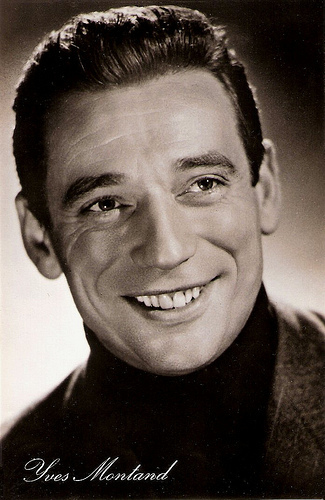
Yves Montand . East-German postcard by VEB Progress Film-Vertrieb, Berlin, no. 807, 1958. Retail price: 0,20 DM.
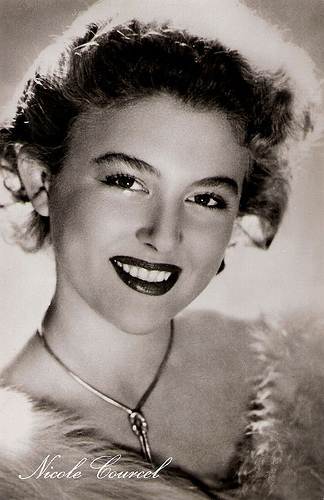
Nicole Courcel . East-German postcard by VEB Progress Filmvertrieb, no. 808, 1958. Retail price: 0,20 DM.
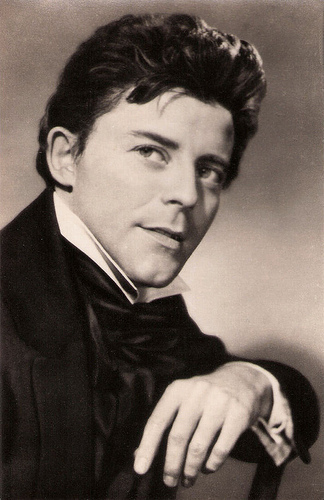
Gérard Philipe . East-German postcard by VEB Progress Filmvertrieb, Berlin, no. 73. Photo: Franco-London-Film S.A. Publicity still for Le rouge et le noir/The Red and the Black (Claude Autant-Lara, 1954).
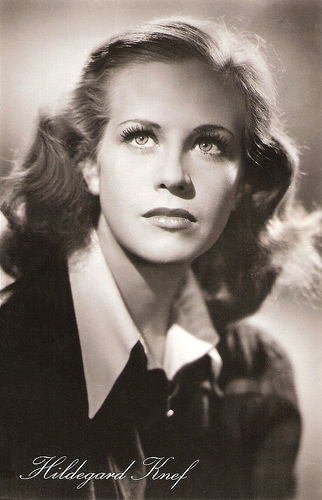
Hildegard Knef . East-German postcard by VEB Progress Film-Vertrieb, Berlin, nr. 7/319. 1957. Photo: DEFA.
A State-owned Company
Progress was founded in 1950, under German-Soviet management. It was a cooperation of the Russian Sovexport and the East-German DEFA film distribution.
The firm, which still exists, was located in the Jäger Strasse 32 in East-Berlin, in the building of the DEFA Studios for newsreels and documentaries. In 1955, Sovexport retired as a partner and the Progress Film-Vertrieb was transformed in a state-owned company.
In the following decades, Progress produced to promote its films thousands of posters, film programmes and also postcards in different sizes. Regular formats of these 'starpostkarten' were 9 x 13 cm during the 1950s and later 10 x 14,5 cm. These cards had a white edge below the photo. In the 1970s, there were also series with colour postcards and A5 format cards (14,7 x 20,7 cm).
I like the Progress Starpostkarten because they gave a unique view on the popular East-European film stars of the period.
The muscular Serbian actor Gojko Mitic for instance, the most famous Indian in Eastern Europe. The handsome star played in numerous Westerns from East-Germany between 1966 and 1984.
Or Angelica Domröse , who played the unforgettable Paula in one of the biggest hits of the DEFA, Die Legende von Paul und Paula/The Legend of Paul and Paula (Heiner Carow, 1973), also with Winfried Glatzeder .
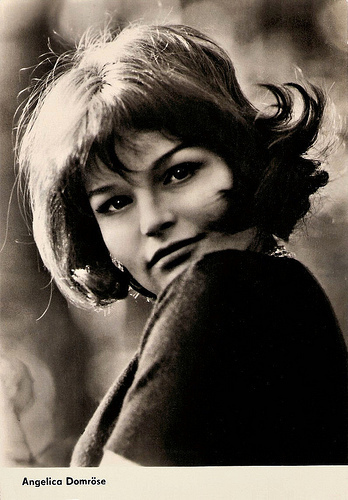
Angelica Domröse . East-German postcard by VEB Progress Filmvertrieb, Berlin, no. 2091, 1964. Retail price: 0,20 DM. Photo: Klaus Fischer.
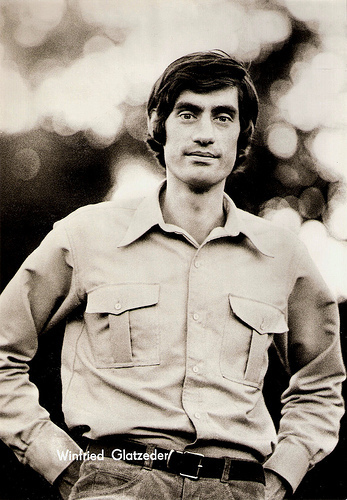
Winfried Glatzeder . Big East-German postcard by VEB Progress Filmvertrieb, Berlin, no. 163/73, 1971. Retail price: 0,50 M. Photo: Linke.
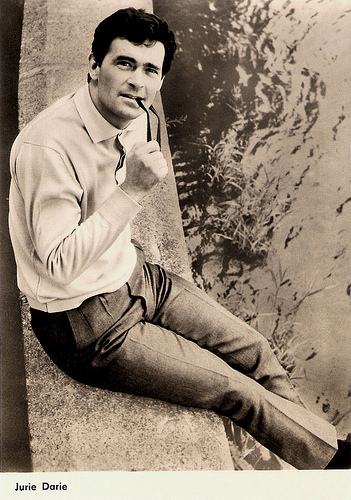
Iurie Darie. East-German postcard by VEB Progress Film-Vertrieb, Berlin, no. 2703, 1966. Retail price: 0,20 M. Photo: Balinski.
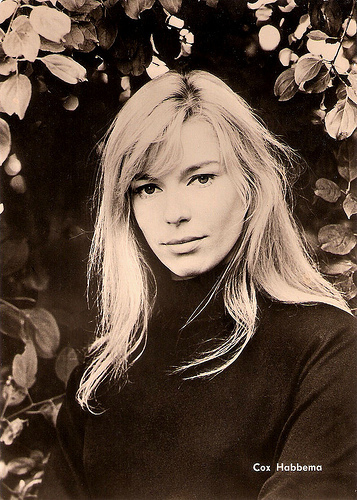
Cox Habbema . East-German postcard by VEB Progress Film-Vertrieb, Berlin, no. 3307, 1968. Retail price: 0,20 DM. Photo: Reinke / DEFA. Publicity still for Wie heiratet man einen König (1968).
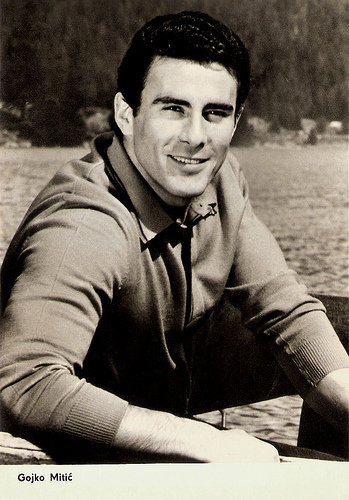
Gojko Mitic . East-German postcard by VEB Progress Film-Vertrieb, Berlin, no. 2930, 1967. Retail price: 0,20 MDN. Photo: Pathenheimer / DEFA.
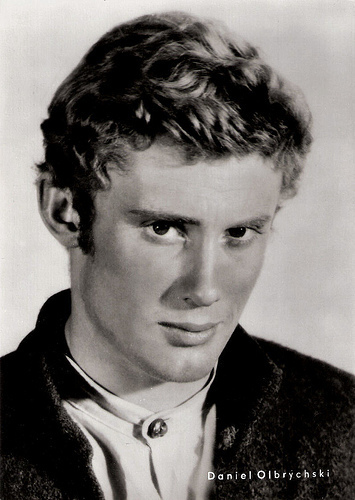
Daniel Olbrychski . East-German postcard by VEB Progress Filmvertrieb, Berlin, no. 117/73, 1973. Retail price: 0,20 M.
A Bit of Ostalghia
The GDR required that 60% of the by Progress distributed films should come from socialist and 40% from non-socialist countries.
So Progress also produced many cards of British, French, Italian and West-German films and its stars. Left-wing stars like Gérard Philipe , Yves Montand and Vanessa Redgrave were obviously popular in East-Germany.
In these cards the foreign photographers were not mentioned. The only photo credit was: Progress. East German photographers whose work often was shown at the Progress cards were in the 1950s Kurt Wunsch and Gerhard Puhlmann, in the 1960s Ludwig Schirmer and Klaus Fischer and in the 1970s Günter Steffen, Peter Söllner and Ute Mahler.
Perhaps surprising, but Hollywood was a permanent guest in the GDR too. American films were loved, but in the 1950s and 1960s only hestitantly imported, not only for political reasons. The licenses for the major Hollywood films were expensive.
In the 1970s more Hollywood films were presented, but with a delay of sometimes ten years. In the early 1980s, the proportion of non-socialist films had grown to 65% and the share of American films 23%.
Today, more than 25 years since the last Progress were produced, there are many collectors like me. A bit of Ostalghia?
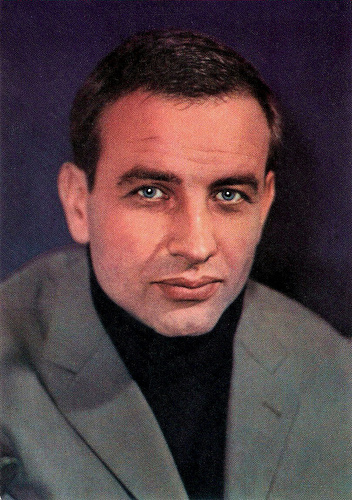
Armin Mueller-Stahl. East-German postcard by VEB Progress Film-Vertrieb, Berlin, no. 2254. Photo: Schirmer.
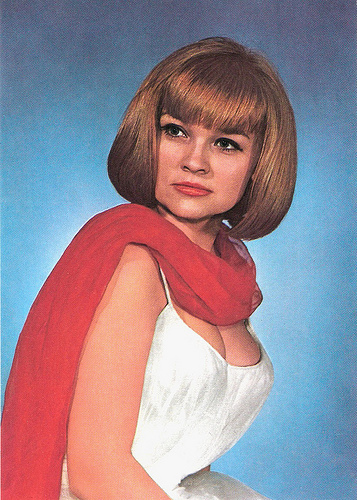
Eva-Maria Hagen . East-German postcard by VEB Progress Film-Vertrieb, Berlin, no. 2249, 1965. Retail price: 0,15 MDN. Photo: Schwarzer.
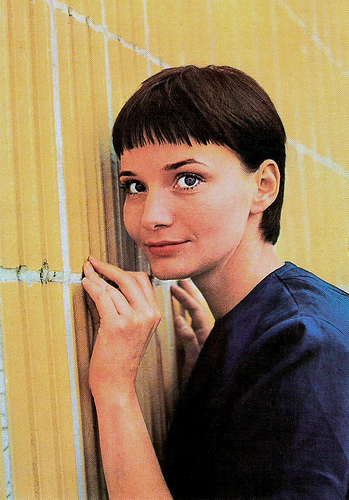
Anna Prucnal. East-German postcard by VEB Progress Film-Vertrieb, Berlin, no. 2259, 1965. Retail price: 0,15 MDN. Photo: Schwarz.
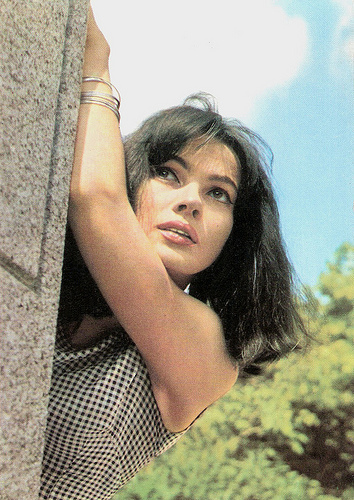
Ewa Krzyzewska . East-German postcard by VEB Progress Filmvertrieb, Berlin, no. 2530, 1966. Retail price: 0,15 MDN. Photo: Balinski.
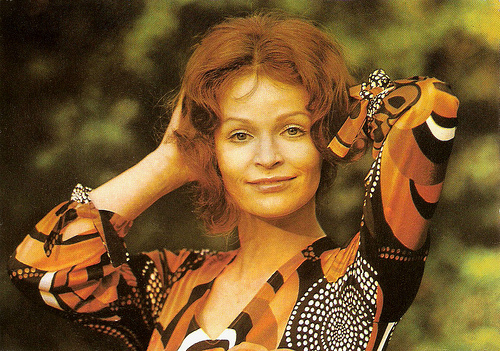
Angelica Domröse . East-German postcard by VEB Progress Film-Vertrieb, Berlin, no. 4/F/73, 1973. Retail price: 0,20 MDN. Photo: Linke.
Next week: the Romanian star postcards of Casa Filmului Acin.
Source: Philipp Humpert (Amerika. Werkleitz festival) (German), Hans-Jürgen Furcht (Archiv Starpostkarten / Schauspielerfotos) (German), Wikipedia (German) and IMDb.

Yves Montand . East-German postcard by VEB Progress Film-Vertrieb, Berlin, no. 807, 1958. Retail price: 0,20 DM.

Nicole Courcel . East-German postcard by VEB Progress Filmvertrieb, no. 808, 1958. Retail price: 0,20 DM.

Gérard Philipe . East-German postcard by VEB Progress Filmvertrieb, Berlin, no. 73. Photo: Franco-London-Film S.A. Publicity still for Le rouge et le noir/The Red and the Black (Claude Autant-Lara, 1954).

Hildegard Knef . East-German postcard by VEB Progress Film-Vertrieb, Berlin, nr. 7/319. 1957. Photo: DEFA.
A State-owned Company
Progress was founded in 1950, under German-Soviet management. It was a cooperation of the Russian Sovexport and the East-German DEFA film distribution.
The firm, which still exists, was located in the Jäger Strasse 32 in East-Berlin, in the building of the DEFA Studios for newsreels and documentaries. In 1955, Sovexport retired as a partner and the Progress Film-Vertrieb was transformed in a state-owned company.
In the following decades, Progress produced to promote its films thousands of posters, film programmes and also postcards in different sizes. Regular formats of these 'starpostkarten' were 9 x 13 cm during the 1950s and later 10 x 14,5 cm. These cards had a white edge below the photo. In the 1970s, there were also series with colour postcards and A5 format cards (14,7 x 20,7 cm).
I like the Progress Starpostkarten because they gave a unique view on the popular East-European film stars of the period.
The muscular Serbian actor Gojko Mitic for instance, the most famous Indian in Eastern Europe. The handsome star played in numerous Westerns from East-Germany between 1966 and 1984.
Or Angelica Domröse , who played the unforgettable Paula in one of the biggest hits of the DEFA, Die Legende von Paul und Paula/The Legend of Paul and Paula (Heiner Carow, 1973), also with Winfried Glatzeder .

Angelica Domröse . East-German postcard by VEB Progress Filmvertrieb, Berlin, no. 2091, 1964. Retail price: 0,20 DM. Photo: Klaus Fischer.

Winfried Glatzeder . Big East-German postcard by VEB Progress Filmvertrieb, Berlin, no. 163/73, 1971. Retail price: 0,50 M. Photo: Linke.

Iurie Darie. East-German postcard by VEB Progress Film-Vertrieb, Berlin, no. 2703, 1966. Retail price: 0,20 M. Photo: Balinski.

Cox Habbema . East-German postcard by VEB Progress Film-Vertrieb, Berlin, no. 3307, 1968. Retail price: 0,20 DM. Photo: Reinke / DEFA. Publicity still for Wie heiratet man einen König (1968).

Gojko Mitic . East-German postcard by VEB Progress Film-Vertrieb, Berlin, no. 2930, 1967. Retail price: 0,20 MDN. Photo: Pathenheimer / DEFA.

Daniel Olbrychski . East-German postcard by VEB Progress Filmvertrieb, Berlin, no. 117/73, 1973. Retail price: 0,20 M.
A Bit of Ostalghia
The GDR required that 60% of the by Progress distributed films should come from socialist and 40% from non-socialist countries.
So Progress also produced many cards of British, French, Italian and West-German films and its stars. Left-wing stars like Gérard Philipe , Yves Montand and Vanessa Redgrave were obviously popular in East-Germany.
In these cards the foreign photographers were not mentioned. The only photo credit was: Progress. East German photographers whose work often was shown at the Progress cards were in the 1950s Kurt Wunsch and Gerhard Puhlmann, in the 1960s Ludwig Schirmer and Klaus Fischer and in the 1970s Günter Steffen, Peter Söllner and Ute Mahler.
Perhaps surprising, but Hollywood was a permanent guest in the GDR too. American films were loved, but in the 1950s and 1960s only hestitantly imported, not only for political reasons. The licenses for the major Hollywood films were expensive.
In the 1970s more Hollywood films were presented, but with a delay of sometimes ten years. In the early 1980s, the proportion of non-socialist films had grown to 65% and the share of American films 23%.
Today, more than 25 years since the last Progress were produced, there are many collectors like me. A bit of Ostalghia?

Armin Mueller-Stahl. East-German postcard by VEB Progress Film-Vertrieb, Berlin, no. 2254. Photo: Schirmer.

Eva-Maria Hagen . East-German postcard by VEB Progress Film-Vertrieb, Berlin, no. 2249, 1965. Retail price: 0,15 MDN. Photo: Schwarzer.

Anna Prucnal. East-German postcard by VEB Progress Film-Vertrieb, Berlin, no. 2259, 1965. Retail price: 0,15 MDN. Photo: Schwarz.

Ewa Krzyzewska . East-German postcard by VEB Progress Filmvertrieb, Berlin, no. 2530, 1966. Retail price: 0,15 MDN. Photo: Balinski.

Angelica Domröse . East-German postcard by VEB Progress Film-Vertrieb, Berlin, no. 4/F/73, 1973. Retail price: 0,20 MDN. Photo: Linke.
Next week: the Romanian star postcards of Casa Filmului Acin.
Source: Philipp Humpert (Amerika. Werkleitz festival) (German), Hans-Jürgen Furcht (Archiv Starpostkarten / Schauspielerfotos) (German), Wikipedia (German) and IMDb.
Published on April 04, 2014 23:00
April 3, 2014
Nola Hatterman
Dutch actress Nola Hatterman (1899-1984) was mainly a stage performer but also played minor parts in five Dutch silent films. From 1925 on, Hatterman worked as an artist who liked to paint people of colour, in particular Afro-Surinamese. During the war, her paintings of blues singers and black men dancing were considered as ‘Entartete Kunst’ by the Nazis.

Dutch postcard by NRM, no. 911. Photo: J. Merkelbach.
Lost Films
Nola Henderika Petronella Hatterman was born in Amsterdam, on August 12, 1899. She was the only child of Johan Herman Rudolph Hatterman and Elisabeth Hendrika Christina Verzijl, and grew up in Watergraafsmeer (now part of Amsterdam).
Nola Hatterman’s father worked for a Dutch East Indies commercial company, and by consequence she met people of colour from the Dutch East Indies, laying the base for her interest in the position but also the depiction of people of colour.
Hatterman followed the theatre academy. As a stage actress, she worked at Het Rotterdams Toneel, Koninklijke Vereeniging Het Nederlandsch Tooneel (KVHNT), Jacques Sluijters company; and Nederlands Vaudevillegezelschap. However, she never played major roles on stage.
As a film actress she performed in five silent Dutch films. The first, Majoor Frans (Maurits Binger, 1916) was a Hollandia film production based on the book by Anna Bosboom-Toussaint. For a long time, the film was considered to be lost, until in 1994 the Netherlands Filmmuseum (EYE) found some reels of the film in a private collection, which the museum had acquired. The film was incomplete and in a bad state but Majoor Frans was restored. The restored version was first screened in 2000.
Silent film star Annie Bos played Majoor Frans, a girl raised as a boy to secure a heritage, starred. Nola Hatterman played a circus girl. Co-stars were Louis Chrispijn , Willem van der Veer, Fred Vogeding and Lily Bouwmeester. A production still with Hatterman, Van der Veer and Minny Erfmann is visible at the website Film in Nederland . Here you can see also a five minute clip from the film.
Helleveeg/Bitch (Theo Frenkel senior, 1920) starred Mien Duymaer van Twist as a ‘golddigger’ who marries a Dutchman (Co Balfoort) to rise the social ladder, but shocks the man’s family and friends and ruins the man’s daughter’s (Lily Bouwmeester) engagement. In the end she is strangled by the man’s brother (Frits Fuchs). Nola Hatterman played a nursemaid. You can see her on a still on Film in Nederland .
Helleveeg premiered in the Netherlands on the very same day as another film by Frenkel in which Hatterman acted: Geeft ons kracht/Give Us Strength (Theo Frenkel senior, 1920). In this film Hatterman had a major part as the sweetheart of a convict (Joop van Hulzen) who killed her out of jealousy. His lawyer (Co Bafoort) sees a parallel with his own affair with an adventuress (Vera van Haeften). Both of Frenkel's films are lost.
A film which still exists is the little known – and rather outdated – one reel farce De bolsjewiek/The Bolshevik (Theo Frenkel senior, 1920), in which Hatterman played the maid of a young widow (Vera van Haeften), who takes an amateur plumber (Daan van Nieuwenhuyzen) for her rich cousin from the States. Director Frenkel had no studio, so the wind blows over the set. Drunken, the plumber blows up the house, similar to Pathé and Gaumont farces of 10 years before. See Film in Nederland for the complete film.
Hatterman’s last film part was in Oranje Hein/Orange Henry (Alex Benno, 1925), a popular so-called Jordaan comedy, based on a play by Herman Bouber and starred Johan Elsensohn , Aaf Bouber (wife of playwright Herman Bouber), Maurits de Vries (Hatterman’s later husband) and Vera van Haeften. Unknown is what Hatterman’s part was and the film is lost.

Mien Duymaer van Twist. Dutch postcard. Photo J. Merkelbach, Amsterdam.
Entartete Kunst
After her film and stage career ended, Nola Hatterman chose to be a fulltime painter in 1925. She didn’t study at an art academy but took private lessons from Charles Haak, who was employed at the Instituut voor Kunstnijverheidsonderwijs (Education in Applied Arts), now Rietveld Academie.
Nola contributed to group exhibitions of Amsterdam art societies: De Onafhankelijken (already from 1919), St. Lucas (from 1927) and De Brug (from 1930). Her works from the 1920s-1930s clearly have traits of New Objectivity.
Hatterman liked to paint people of colour, in particular Afro-Surinamese. Thanks to Haak she met Surinam people who modelled for her. In 1930 she painted her most famous work, Het terras (The Terrace), depicting the Surinam tap dancer, boxer, model and bar keeper Jimmy van der Lak. The work is related to New Objectivity and is now in the collection of the Amsterdam Stedelijk Museum. In 1939 Hatterman had her first solo exhibition, where she had to defend her focus on black men – something the renowned Dutch painter Jan Sluyters, who also had painted black people, never had to do.
After an affair with Dick/Dirk van Veen, in 1929 Hatterman went to live together with Maurits de Vries, known as actor but also director of the Jordaan comedy De Jantjes and author of the novel De man zonder moraal (The Man Without Morals). In 1931 they married, but apparently the difference in age and temper (Hatterman was a very lively character) caused Hatterman to leave him in 1938 and move in with artist Arie de Vries, who lived not far from Falckstraat, where Hatterman had her studio.
In September 1940, when the Germans had already occupied the Netherlands, she officially divorced De Vries. The Jewish De Vries went into hiding thanks to his new girlfriend Cor Krienen, who ran a boarding house. Hatterman’s paintings of blues singers and Surinam black men dancing were considered as ‘Entartete Kunst’ by the Nazis. During the war she housed various Surinam people in her house on Falckstraat 9.
After the war Hatterman’s realist style estranged her from young art circles. Because of her cultural-political engagement she was asked to contribute to the first post-war exhibition at the Amsterdam Stedelijk Museum in 1945, Kunst in vrijheid (Art in Liberation), and in 1950 she had her own exhibition in London, including a black Christ mourned by his mother, which newspaper Daily Herald called 'Europe’s most controversial painting'.
Her house had become the sweeping centre of the Surinam cultural-nationalist movement Wie Eegie Sanie (Our Own Thing), founded in 1951. In 1953 she so longed for Surinam that she moved there. She arrived in Surinam without a penny in her pocket, but she was helped by families and started to teach pottery lessons to rich black and white ladies.
Quickly she established herself as a cherished visual artist in Surinam. She didn’t get rich because with her art but became a respected artist and personality. She also opened a school for painting, becoming one of the founders of art education in the country. In the 1960s-1980s many of her pupils went to the Netherlands and elsewhere in Europe to pursue careers as artists.
Nola Hatterman died in 1984, because of a car accident, on the road between her house in Brokopondo and Paramaribo. After her death, former students founded the Nola Hatterman Institute, where thousands of children were taught painting and drawing.
In 1982 Frank Zichem made a documentary about her: Nola, de konsekwente keuze/Nola, the Consequent Choice. In 1997 the gallery exploited by Vereniging Ons Suriname was named after her. Yearly, an artist attached to the Nola Hatterman Institute is enabled to exhibit there. The Nola Hatterman Institute, part of the Fort Zeelandia complex, was fully restored between 2004 and 2005.
In 2008 Ellen de Vries published Nola, portret van een eigenzinnige kunstenares (Nola, Portrait of a Headstrong Artist).

Louis Chrispijn . Dutch postcard by Weenenk & Snel, Den Haag. Photo: Willem Coret.
Sources: Geoffrey Donaldson (Of Joy and Sorrow), Nolahatterman.nl (Dutch), Filminnederland.nl, DBNL, Wikipedia (Dutch and French) and . And our secial thanks to Gé Joosten.

Dutch postcard by NRM, no. 911. Photo: J. Merkelbach.
Lost Films
Nola Henderika Petronella Hatterman was born in Amsterdam, on August 12, 1899. She was the only child of Johan Herman Rudolph Hatterman and Elisabeth Hendrika Christina Verzijl, and grew up in Watergraafsmeer (now part of Amsterdam).
Nola Hatterman’s father worked for a Dutch East Indies commercial company, and by consequence she met people of colour from the Dutch East Indies, laying the base for her interest in the position but also the depiction of people of colour.
Hatterman followed the theatre academy. As a stage actress, she worked at Het Rotterdams Toneel, Koninklijke Vereeniging Het Nederlandsch Tooneel (KVHNT), Jacques Sluijters company; and Nederlands Vaudevillegezelschap. However, she never played major roles on stage.
As a film actress she performed in five silent Dutch films. The first, Majoor Frans (Maurits Binger, 1916) was a Hollandia film production based on the book by Anna Bosboom-Toussaint. For a long time, the film was considered to be lost, until in 1994 the Netherlands Filmmuseum (EYE) found some reels of the film in a private collection, which the museum had acquired. The film was incomplete and in a bad state but Majoor Frans was restored. The restored version was first screened in 2000.
Silent film star Annie Bos played Majoor Frans, a girl raised as a boy to secure a heritage, starred. Nola Hatterman played a circus girl. Co-stars were Louis Chrispijn , Willem van der Veer, Fred Vogeding and Lily Bouwmeester. A production still with Hatterman, Van der Veer and Minny Erfmann is visible at the website Film in Nederland . Here you can see also a five minute clip from the film.
Helleveeg/Bitch (Theo Frenkel senior, 1920) starred Mien Duymaer van Twist as a ‘golddigger’ who marries a Dutchman (Co Balfoort) to rise the social ladder, but shocks the man’s family and friends and ruins the man’s daughter’s (Lily Bouwmeester) engagement. In the end she is strangled by the man’s brother (Frits Fuchs). Nola Hatterman played a nursemaid. You can see her on a still on Film in Nederland .
Helleveeg premiered in the Netherlands on the very same day as another film by Frenkel in which Hatterman acted: Geeft ons kracht/Give Us Strength (Theo Frenkel senior, 1920). In this film Hatterman had a major part as the sweetheart of a convict (Joop van Hulzen) who killed her out of jealousy. His lawyer (Co Bafoort) sees a parallel with his own affair with an adventuress (Vera van Haeften). Both of Frenkel's films are lost.
A film which still exists is the little known – and rather outdated – one reel farce De bolsjewiek/The Bolshevik (Theo Frenkel senior, 1920), in which Hatterman played the maid of a young widow (Vera van Haeften), who takes an amateur plumber (Daan van Nieuwenhuyzen) for her rich cousin from the States. Director Frenkel had no studio, so the wind blows over the set. Drunken, the plumber blows up the house, similar to Pathé and Gaumont farces of 10 years before. See Film in Nederland for the complete film.
Hatterman’s last film part was in Oranje Hein/Orange Henry (Alex Benno, 1925), a popular so-called Jordaan comedy, based on a play by Herman Bouber and starred Johan Elsensohn , Aaf Bouber (wife of playwright Herman Bouber), Maurits de Vries (Hatterman’s later husband) and Vera van Haeften. Unknown is what Hatterman’s part was and the film is lost.

Mien Duymaer van Twist. Dutch postcard. Photo J. Merkelbach, Amsterdam.
Entartete Kunst
After her film and stage career ended, Nola Hatterman chose to be a fulltime painter in 1925. She didn’t study at an art academy but took private lessons from Charles Haak, who was employed at the Instituut voor Kunstnijverheidsonderwijs (Education in Applied Arts), now Rietveld Academie.
Nola contributed to group exhibitions of Amsterdam art societies: De Onafhankelijken (already from 1919), St. Lucas (from 1927) and De Brug (from 1930). Her works from the 1920s-1930s clearly have traits of New Objectivity.
Hatterman liked to paint people of colour, in particular Afro-Surinamese. Thanks to Haak she met Surinam people who modelled for her. In 1930 she painted her most famous work, Het terras (The Terrace), depicting the Surinam tap dancer, boxer, model and bar keeper Jimmy van der Lak. The work is related to New Objectivity and is now in the collection of the Amsterdam Stedelijk Museum. In 1939 Hatterman had her first solo exhibition, where she had to defend her focus on black men – something the renowned Dutch painter Jan Sluyters, who also had painted black people, never had to do.
After an affair with Dick/Dirk van Veen, in 1929 Hatterman went to live together with Maurits de Vries, known as actor but also director of the Jordaan comedy De Jantjes and author of the novel De man zonder moraal (The Man Without Morals). In 1931 they married, but apparently the difference in age and temper (Hatterman was a very lively character) caused Hatterman to leave him in 1938 and move in with artist Arie de Vries, who lived not far from Falckstraat, where Hatterman had her studio.
In September 1940, when the Germans had already occupied the Netherlands, she officially divorced De Vries. The Jewish De Vries went into hiding thanks to his new girlfriend Cor Krienen, who ran a boarding house. Hatterman’s paintings of blues singers and Surinam black men dancing were considered as ‘Entartete Kunst’ by the Nazis. During the war she housed various Surinam people in her house on Falckstraat 9.
After the war Hatterman’s realist style estranged her from young art circles. Because of her cultural-political engagement she was asked to contribute to the first post-war exhibition at the Amsterdam Stedelijk Museum in 1945, Kunst in vrijheid (Art in Liberation), and in 1950 she had her own exhibition in London, including a black Christ mourned by his mother, which newspaper Daily Herald called 'Europe’s most controversial painting'.
Her house had become the sweeping centre of the Surinam cultural-nationalist movement Wie Eegie Sanie (Our Own Thing), founded in 1951. In 1953 she so longed for Surinam that she moved there. She arrived in Surinam without a penny in her pocket, but she was helped by families and started to teach pottery lessons to rich black and white ladies.
Quickly she established herself as a cherished visual artist in Surinam. She didn’t get rich because with her art but became a respected artist and personality. She also opened a school for painting, becoming one of the founders of art education in the country. In the 1960s-1980s many of her pupils went to the Netherlands and elsewhere in Europe to pursue careers as artists.
Nola Hatterman died in 1984, because of a car accident, on the road between her house in Brokopondo and Paramaribo. After her death, former students founded the Nola Hatterman Institute, where thousands of children were taught painting and drawing.
In 1982 Frank Zichem made a documentary about her: Nola, de konsekwente keuze/Nola, the Consequent Choice. In 1997 the gallery exploited by Vereniging Ons Suriname was named after her. Yearly, an artist attached to the Nola Hatterman Institute is enabled to exhibit there. The Nola Hatterman Institute, part of the Fort Zeelandia complex, was fully restored between 2004 and 2005.
In 2008 Ellen de Vries published Nola, portret van een eigenzinnige kunstenares (Nola, Portrait of a Headstrong Artist).

Louis Chrispijn . Dutch postcard by Weenenk & Snel, Den Haag. Photo: Willem Coret.
Sources: Geoffrey Donaldson (Of Joy and Sorrow), Nolahatterman.nl (Dutch), Filminnederland.nl, DBNL, Wikipedia (Dutch and French) and . And our secial thanks to Gé Joosten.
Published on April 03, 2014 23:00
April 2, 2014
One of the most wanted lost films found!
Yesterday, 2 April 2014, was anounced that a long-lost film has been found in the collection of Eye Film Institute in Amsterdam, The Netherlands. After more than ninety years, the silent film Love, Life and Laughter (George Pearson, 1923), starring Betty Balfour was recovered. A copy of the British production was found in the inventory of bioscoop/theater De Vries (cinema/theatre De Vries), a former cinema in Hattem, the Netherlands. The film was listed as one of the British Film Institute's '75 Most Wanted' lost films. Great news. So today's post is on Betty Balfour.
Betty Balfour (1903-1977) was a gamine-like silent screen star, nicknamed the ‘British Mary Pickford’. She was a great mimic who started in Music Hall and became known as ‘Britain's Queen of Happiness’. During the 1920s, Balfour was Britain’s most popular actress.
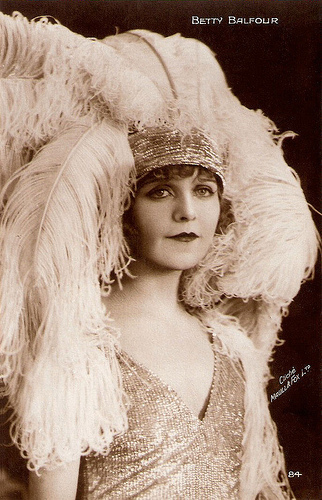
French postcard by Cinémagazine Edition, no. 84. Photo: Maull & Fox.
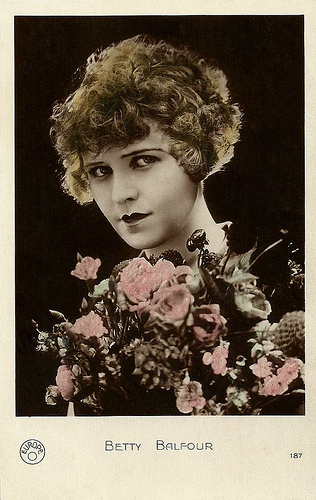
French postcard by Europe, no. 187.
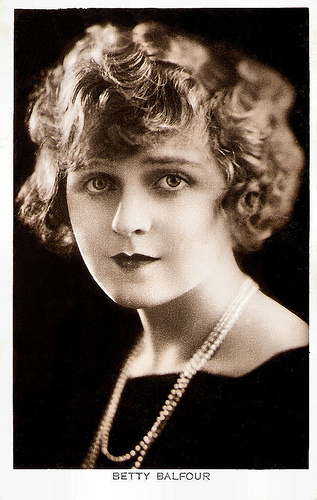
British postcard by Real Photograph.
Comic Charm
Betty Balfour was born in London, Great Britain, in 1903. She made her stage debut at the age of 10 (in 1913 or 1914 – the sources differ) at the Court Theatre and she became one of C. B. Cochran's stars.
Years later, when she was appearing in Medora at the Alhambra Theatre, film makers T. A. Welsh and George Pearson saw her and were impressed by Balfour’s delicate expression and comic charm. They signed her for her film debut in Nothing Else Matters (George Pearson, 1920) with Hugh E. Wright.
Betty instantly showcased her comic talents. After replacing Gertrude Lawrence on stage in The Midnight Follies, Balfour was back with Pearson for her first starring role in Mary-Find-the-Gold (George Pearson, 1921).
It was her role as the wayward florist Squibs Hopkins in Squibs (George Pearson, 1921) that established Balfour as a national star, creating a persona that would both propel and restrict her career. Squibs is a cockney flower girl working at Piccadilly Circus, and this proved to be the ideal vehicle for Balfour’s cheerful disposition, amidst a dreary London setting.
The instant success of the film lead to three sequels, Squibs Wins the Calcutta Sweep (George Pearson, 1922), Squibs M.P. (George Pearson, 1923) and Squibs’ Honeymoon (George Pearson, 1923).
In the Encyclopedia of British Film , Brian McFarlane calls Balfour "a great mimic". At the beautiful website Women and British Silent Cinema , Dan Horn writes that "it was this refreshing charisma, typified in Squibs, which made Balfour an icon of the silent era". Horn quotes film historian Rachael Low, who comments that Balfour was "able to register on screen a charm and expression unequalled among the actresses in British film".
In the more gritty productions Love, Life and Laughter (George Pearson, 1923) and Reveille (George Pearson, 1924), she demonstrated a more serious side to her character.
When Betty rejected Pearson's offer to divorce his wife and marry hér, her professional partnership with Welsh-Pearson ended. Their final film together was Blinkeyes (George Pearson, 1926).
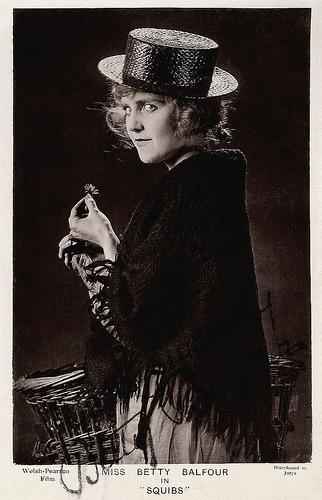
British postcard by Jurys. Photo: Welsh-Pearson Film. Still from Squibs (1921).
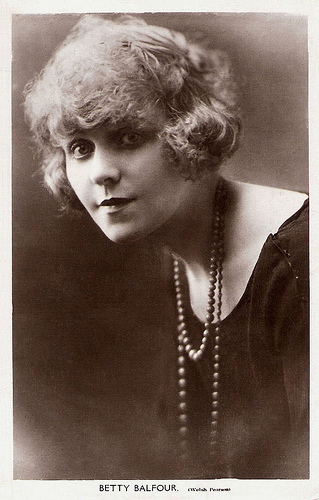
British postcard in the Picturegoer Series, London, no. 2. Photo: Welsh-Pearson Film.
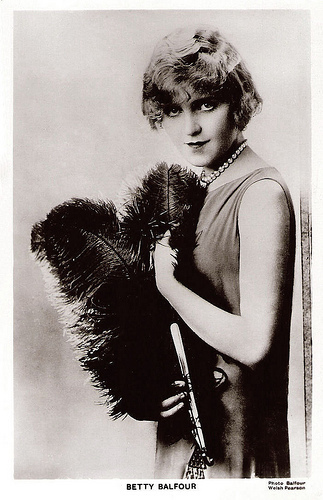
British postcard in the Picturegoer Series, London, no. 226. Sent by mail in Great Britain in 1928. Photo: Balfour Welsh Pearson.
The Country's Favorite World Star
At the time, Betty Balfour was the most popular actress in Britain, and in 1927 the newspaper Daily Mirror named her as the country's favorite world star. The popular Squibs films, and an array of product endorsements, ensured that Balfour’s vast fan base had flourished.
Balfour made no attempt to break into Hollywood but like Ivor Novello she was able to export her talents to mainland Europe.
She starred in the German films Die sieben Töchter der Frau Gyurkovics/A Sister of Six (Ragnar Hylten-Cavallius, 1926) with Willy Fritsch , and Die Regimentstochter/Daughter of the Regiment (Hans Behrendt, 1929), in the French films La Petite Bonne du Palace/The Little Maid at the Palace (Louis Mercanton, 1926), Le Diable au Coeur/Little Devil May Care (Marcel L'Herbier, 1927) with Jaque Catelain , and Croquette (Louis Mercanton, 1927), and in the Austrian-British production Champagner/Bright Eyes (Géza von Bolváry, 1929) with Jack Trevor .
In these films she re-established herself as a sophisticated, fashionable woman of the world, far removed from the persona that had typecast her. Consequently, her popularity in Britain began to decline.
Back in Britain, she featured successfully in Alfred Hitchcock's comedy Champagne (1928), but Balfour's sound debut The Nipper/The Brat (Louis Mercanton, 1930), based on the Squibs character, was only moderately successful.
Her popularity diminished in the 1930s, and Balfour began to struggle for leading roles. She only played a supporting role to Jessie Matthews in Evergreen (Victor Saville, 1934) and appeared with John Mills in Brown on Resolution/Forever England (Walter Forde, 1935).
Even a musical remake of Squibs (Henry Lawson, 1935) with Stanley Holloway was unable to recapture her former popularity.
In 1945, after a nine year hiatus, Balfour appeared in 29 Acacia Avenue (Henry Cass, 1945) starring Gordon Harker. This was to be her final film.
'Britain's Queen of Happiness' was not happy in her private life. After a stage comeback failed in 1952, she attempted suicide. For the last 20 years of her life she was a recluse.
At age 74, Betty Balfour died in 1977 or 1978 (the sources differ), in Weybridge, England. She had been married once, to composer Jimmy Campbell from 1931 till their divorce in 1941. They had one child.
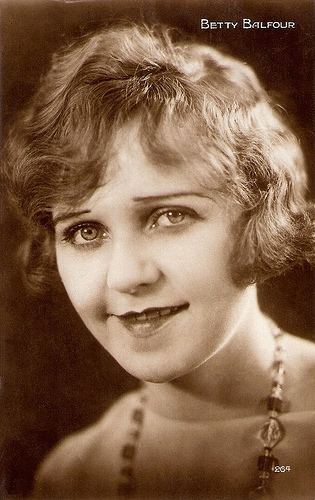
French postcard by Cinémagazine Edition, no. 264.
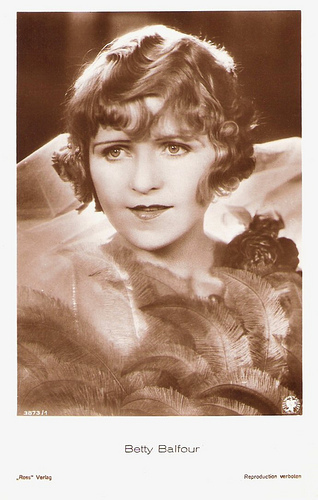
German postcard by Ross Verlag, no. 3873/1, 1928 - 1929. Photo: Imperial Film.
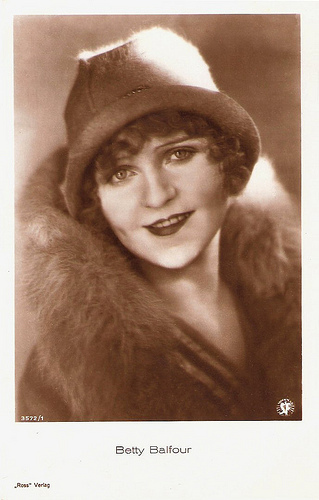
German postcard by Ross Verlag, no. 3572/1, 1928 - 1929. Photo: Imperial Film.
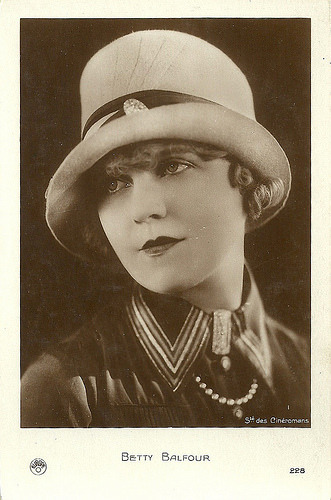
French postcard by Europe, no. 228. Photo: Société des Cinéromans.
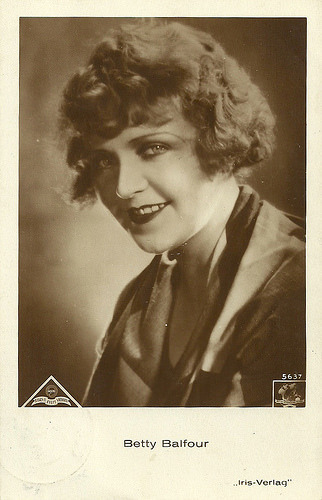
Austrian postcard by Iris Verlag. Photo: Sascha Film, Vienna.
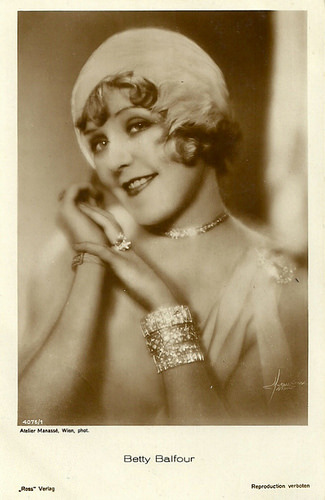
German postcard by Ross Verlag, no. 4076/1, 1929-1930. Photo: Atelier Manassé, Vienna.
Sources: Brian McFarlane (Encyclopedia of British Film), Dan Horn (Women and British Silent Cinema), Wikipedia, and .
Betty Balfour (1903-1977) was a gamine-like silent screen star, nicknamed the ‘British Mary Pickford’. She was a great mimic who started in Music Hall and became known as ‘Britain's Queen of Happiness’. During the 1920s, Balfour was Britain’s most popular actress.

French postcard by Cinémagazine Edition, no. 84. Photo: Maull & Fox.

French postcard by Europe, no. 187.

British postcard by Real Photograph.
Comic Charm
Betty Balfour was born in London, Great Britain, in 1903. She made her stage debut at the age of 10 (in 1913 or 1914 – the sources differ) at the Court Theatre and she became one of C. B. Cochran's stars.
Years later, when she was appearing in Medora at the Alhambra Theatre, film makers T. A. Welsh and George Pearson saw her and were impressed by Balfour’s delicate expression and comic charm. They signed her for her film debut in Nothing Else Matters (George Pearson, 1920) with Hugh E. Wright.
Betty instantly showcased her comic talents. After replacing Gertrude Lawrence on stage in The Midnight Follies, Balfour was back with Pearson for her first starring role in Mary-Find-the-Gold (George Pearson, 1921).
It was her role as the wayward florist Squibs Hopkins in Squibs (George Pearson, 1921) that established Balfour as a national star, creating a persona that would both propel and restrict her career. Squibs is a cockney flower girl working at Piccadilly Circus, and this proved to be the ideal vehicle for Balfour’s cheerful disposition, amidst a dreary London setting.
The instant success of the film lead to three sequels, Squibs Wins the Calcutta Sweep (George Pearson, 1922), Squibs M.P. (George Pearson, 1923) and Squibs’ Honeymoon (George Pearson, 1923).
In the Encyclopedia of British Film , Brian McFarlane calls Balfour "a great mimic". At the beautiful website Women and British Silent Cinema , Dan Horn writes that "it was this refreshing charisma, typified in Squibs, which made Balfour an icon of the silent era". Horn quotes film historian Rachael Low, who comments that Balfour was "able to register on screen a charm and expression unequalled among the actresses in British film".
In the more gritty productions Love, Life and Laughter (George Pearson, 1923) and Reveille (George Pearson, 1924), she demonstrated a more serious side to her character.
When Betty rejected Pearson's offer to divorce his wife and marry hér, her professional partnership with Welsh-Pearson ended. Their final film together was Blinkeyes (George Pearson, 1926).

British postcard by Jurys. Photo: Welsh-Pearson Film. Still from Squibs (1921).

British postcard in the Picturegoer Series, London, no. 2. Photo: Welsh-Pearson Film.

British postcard in the Picturegoer Series, London, no. 226. Sent by mail in Great Britain in 1928. Photo: Balfour Welsh Pearson.
The Country's Favorite World Star
At the time, Betty Balfour was the most popular actress in Britain, and in 1927 the newspaper Daily Mirror named her as the country's favorite world star. The popular Squibs films, and an array of product endorsements, ensured that Balfour’s vast fan base had flourished.
Balfour made no attempt to break into Hollywood but like Ivor Novello she was able to export her talents to mainland Europe.
She starred in the German films Die sieben Töchter der Frau Gyurkovics/A Sister of Six (Ragnar Hylten-Cavallius, 1926) with Willy Fritsch , and Die Regimentstochter/Daughter of the Regiment (Hans Behrendt, 1929), in the French films La Petite Bonne du Palace/The Little Maid at the Palace (Louis Mercanton, 1926), Le Diable au Coeur/Little Devil May Care (Marcel L'Herbier, 1927) with Jaque Catelain , and Croquette (Louis Mercanton, 1927), and in the Austrian-British production Champagner/Bright Eyes (Géza von Bolváry, 1929) with Jack Trevor .
In these films she re-established herself as a sophisticated, fashionable woman of the world, far removed from the persona that had typecast her. Consequently, her popularity in Britain began to decline.
Back in Britain, she featured successfully in Alfred Hitchcock's comedy Champagne (1928), but Balfour's sound debut The Nipper/The Brat (Louis Mercanton, 1930), based on the Squibs character, was only moderately successful.
Her popularity diminished in the 1930s, and Balfour began to struggle for leading roles. She only played a supporting role to Jessie Matthews in Evergreen (Victor Saville, 1934) and appeared with John Mills in Brown on Resolution/Forever England (Walter Forde, 1935).
Even a musical remake of Squibs (Henry Lawson, 1935) with Stanley Holloway was unable to recapture her former popularity.
In 1945, after a nine year hiatus, Balfour appeared in 29 Acacia Avenue (Henry Cass, 1945) starring Gordon Harker. This was to be her final film.
'Britain's Queen of Happiness' was not happy in her private life. After a stage comeback failed in 1952, she attempted suicide. For the last 20 years of her life she was a recluse.
At age 74, Betty Balfour died in 1977 or 1978 (the sources differ), in Weybridge, England. She had been married once, to composer Jimmy Campbell from 1931 till their divorce in 1941. They had one child.

French postcard by Cinémagazine Edition, no. 264.

German postcard by Ross Verlag, no. 3873/1, 1928 - 1929. Photo: Imperial Film.

German postcard by Ross Verlag, no. 3572/1, 1928 - 1929. Photo: Imperial Film.

French postcard by Europe, no. 228. Photo: Société des Cinéromans.

Austrian postcard by Iris Verlag. Photo: Sascha Film, Vienna.

German postcard by Ross Verlag, no. 4076/1, 1929-1930. Photo: Atelier Manassé, Vienna.
Sources: Brian McFarlane (Encyclopedia of British Film), Dan Horn (Women and British Silent Cinema), Wikipedia, and .
Published on April 02, 2014 15:00
April 1, 2014
Gus Backus
American singer and actor Gus Backus (1937) was at 19 a member of the Del-Vikings, and later became virtually the flesh-and-blood embodiment of rock and roll in Germany. Between 1959 and 1965 he also appeared in 25 German light entertainment films.
Dutch postcard, no. 262.
Dutch postcard by Hercules, Haarlem, no. 262.
Doo-Wop
Gus Backus was born as Donald Edgar Backus in Southampton on Long Island, New York, in 1937. His father, a foreman on a potatoe plantation, called him Gus.
Like millions of other young Americans of the period, Backus discovered rhythm-and-blues and rock and roll during his teens as it got onto the radio. He started writing and playing his own music, under the influence of Fats Domino, Little Richard, and Chuck Berry.
At 14, Gus ran away from home when his parents divorced. In Brooklyn, Gus wanted to become a doctor and he worked as a singing shoe cleaner to pay for his medicine studies.
In 1956, Backus was drafted into the US Air Force, and was stationed in Pittsburgh, PA. There he became the lead singer of the multiracial Doo Wop group The Del-Vikings, and at 19 he scored a #12-hit with Cool shake. The following year Backus was stationed in the German city of Wiesbaden and had to leave The Del-Vikings.
In 1958, while home on leave, he cut a single, My Chick Is Fine b/w You Can't Go It Alone, both songs that he wrote or co-wrote, for the Carlton Records label. At All Music , Bruce Eder loves this song: "My Chick Is Fine is one of the great lost classics of rockabilly, a driving, raunchy, hard-rocking tribute to an idealized object of teenage lust that should have been a signature of the era."
After his compulsory military service was finished he decided to stay and settle in Germany. He married and would have four children. His brother-in-law suggested him to record German language versions of English hits for the German market. His first single, Ab und zu/Now and Then, was a cover of Elvis Presley’s A fool such as I.
That same year he also made his film début, singing a song in Paradies der Matrosen/Paradise for sailors (Harald Reinl, 1959) starring Margit Saad . He also appeared in Mein Schatz, komm mit ans blaue Meer/Come to the Blue Sea, My Dear (Rudolf Schündler, 1959) with Joachim Fuchsberger .
German postcard by ISV, no. K 15, sent by mail in 1964. Photo: E. Schneider.
German postcard by ISV, no. K 18. Photo: E. Schneider.
German postcard by ISV, no. K 24. Photo: E. Schneider.
German postcard by Krüger, no. 902/158. Photo: Ufa.
Schlagerfilms
In 1960 Gus Backus had his breakthrough with the single Brauner Bär und weiße Taube/Brown bear and White Doves, a cover of Johnny Preston’s hit Running Bear.
Immediately, he went on with a series of successful follow-ups like Muß i denn and Da sprach der alte Haüptling/And So Spoke the Old Chief. His repertory consisted of German language covers of great hits but also of new songs, mainly Schlagers.
He continued to make Schlagerfilms like ...und du, mein Schatz, bleibst hier/And You, My Dear, Stay Here (Franz Antel, 1961) with Vivi Bach , and Unsere tollen Tanten/Our Awesome Aunts (Rolf Olsen, 1961) with Gunther Philipp.
He had his first #1-hit in Germany in 1961 with Der Mann im Mond/The Man in the Moon. Till 1963 followed such Top 10 hits like Sauerkraut-Polka, No Bier, no Wein, no Schnaps, Linda, Das Lied vom Angeln, and Er macht mich krank, der Mondschein an der Donau.
Between 1959 and 1965 Gus Backus appeared in a total of nearly 25 German entertainment films, including Ohne Krimi geht die Mimi nie ins Bett/Mimi Never Goes to Bed Without a Detective (Franz Antel, 1962) starring comedian Heinz Erhardt, Holiday in St. Tropez (Ernst Hofbauer, 1964), and the boring thriller Hotel der toten Gästen/Hotel of the Dead Guests (Eberhard Itzenplitz, 1965) with Karin Dor .
In 1964 the Beat music conquered the German charts and it became harder for Gus to score hits. In 1973 he decided to return to the USA and went to work as a foreman in the Texan oil fields.
In the 1980s he returned to Germany to surf the Oldies wave of that period. He settled with his family in München (Munich), where he still lives today. Gus Backus now performs his old hits with the group Teddy und die Lollipops.
Gus Backus sings Da sprach der alte Häuptling der Indianer (Then the old chief of the Indians spoke). Scene from Schön ist die Liebe am Königssee/Beautiful is the love in Koenigssee (Hans Albin, 1961). Source: The Barneys Place (YouTube).
Gus Backus sings Der Mann im Mond (The Man in the Moon). Scene from Schlagerrevue 1962/Schlager Revue 1962 (Thomas Engel, 1961). Source: Fritz51464 (YouTube).
Sources: Bruce Eder (AllMusic), Wikipedia (Dutch), and . See also: www.gusbackus.de/ (German).
Dutch postcard, no. 262.
Dutch postcard by Hercules, Haarlem, no. 262.
Doo-Wop
Gus Backus was born as Donald Edgar Backus in Southampton on Long Island, New York, in 1937. His father, a foreman on a potatoe plantation, called him Gus.
Like millions of other young Americans of the period, Backus discovered rhythm-and-blues and rock and roll during his teens as it got onto the radio. He started writing and playing his own music, under the influence of Fats Domino, Little Richard, and Chuck Berry.
At 14, Gus ran away from home when his parents divorced. In Brooklyn, Gus wanted to become a doctor and he worked as a singing shoe cleaner to pay for his medicine studies.
In 1956, Backus was drafted into the US Air Force, and was stationed in Pittsburgh, PA. There he became the lead singer of the multiracial Doo Wop group The Del-Vikings, and at 19 he scored a #12-hit with Cool shake. The following year Backus was stationed in the German city of Wiesbaden and had to leave The Del-Vikings.
In 1958, while home on leave, he cut a single, My Chick Is Fine b/w You Can't Go It Alone, both songs that he wrote or co-wrote, for the Carlton Records label. At All Music , Bruce Eder loves this song: "My Chick Is Fine is one of the great lost classics of rockabilly, a driving, raunchy, hard-rocking tribute to an idealized object of teenage lust that should have been a signature of the era."
After his compulsory military service was finished he decided to stay and settle in Germany. He married and would have four children. His brother-in-law suggested him to record German language versions of English hits for the German market. His first single, Ab und zu/Now and Then, was a cover of Elvis Presley’s A fool such as I.
That same year he also made his film début, singing a song in Paradies der Matrosen/Paradise for sailors (Harald Reinl, 1959) starring Margit Saad . He also appeared in Mein Schatz, komm mit ans blaue Meer/Come to the Blue Sea, My Dear (Rudolf Schündler, 1959) with Joachim Fuchsberger .
German postcard by ISV, no. K 15, sent by mail in 1964. Photo: E. Schneider.
German postcard by ISV, no. K 18. Photo: E. Schneider.
German postcard by ISV, no. K 24. Photo: E. Schneider.
German postcard by Krüger, no. 902/158. Photo: Ufa.
Schlagerfilms
In 1960 Gus Backus had his breakthrough with the single Brauner Bär und weiße Taube/Brown bear and White Doves, a cover of Johnny Preston’s hit Running Bear.
Immediately, he went on with a series of successful follow-ups like Muß i denn and Da sprach der alte Haüptling/And So Spoke the Old Chief. His repertory consisted of German language covers of great hits but also of new songs, mainly Schlagers.
He continued to make Schlagerfilms like ...und du, mein Schatz, bleibst hier/And You, My Dear, Stay Here (Franz Antel, 1961) with Vivi Bach , and Unsere tollen Tanten/Our Awesome Aunts (Rolf Olsen, 1961) with Gunther Philipp.
He had his first #1-hit in Germany in 1961 with Der Mann im Mond/The Man in the Moon. Till 1963 followed such Top 10 hits like Sauerkraut-Polka, No Bier, no Wein, no Schnaps, Linda, Das Lied vom Angeln, and Er macht mich krank, der Mondschein an der Donau.
Between 1959 and 1965 Gus Backus appeared in a total of nearly 25 German entertainment films, including Ohne Krimi geht die Mimi nie ins Bett/Mimi Never Goes to Bed Without a Detective (Franz Antel, 1962) starring comedian Heinz Erhardt, Holiday in St. Tropez (Ernst Hofbauer, 1964), and the boring thriller Hotel der toten Gästen/Hotel of the Dead Guests (Eberhard Itzenplitz, 1965) with Karin Dor .
In 1964 the Beat music conquered the German charts and it became harder for Gus to score hits. In 1973 he decided to return to the USA and went to work as a foreman in the Texan oil fields.
In the 1980s he returned to Germany to surf the Oldies wave of that period. He settled with his family in München (Munich), where he still lives today. Gus Backus now performs his old hits with the group Teddy und die Lollipops.
Gus Backus sings Da sprach der alte Häuptling der Indianer (Then the old chief of the Indians spoke). Scene from Schön ist die Liebe am Königssee/Beautiful is the love in Koenigssee (Hans Albin, 1961). Source: The Barneys Place (YouTube).
Gus Backus sings Der Mann im Mond (The Man in the Moon). Scene from Schlagerrevue 1962/Schlager Revue 1962 (Thomas Engel, 1961). Source: Fritz51464 (YouTube).
Sources: Bruce Eder (AllMusic), Wikipedia (Dutch), and . See also: www.gusbackus.de/ (German).
Published on April 01, 2014 23:00
March 31, 2014
Marie-France Pisier
Refined beauty Marie-France Pisier (1944-2011) was a French actress, screenwriter, and director. She was discovered by François Truffaut and became his muse. She later also worked with such auteurs as Luis Buñuel, Jacques Rivette, Raúl Ruiz and André Techiné. Pisier twice earned the César Award for Best Supporting Actress. The international success of the comedy Cousin, Cousine (1977) brought her to Hollywood, where she had a short and unhappy detour.
Romanian postcard by Casa Filmului Acin.
Truffaut and the Nouvelle Vague
Marie-France Pisier was born in Dalat, French Indochina, where her father was serving as colonial governor. Her younger brother, Gilles Pisier, is a mathematician and a member of the French Academy of Sciences. Her sister, Evelyne, was the first wife of Bernard Kouchner, a French politician and the co-founder of Doctors Without Borders.
The family moved to Paris when Marie-France was twelve years old. As a teenager, she began acting with an amateur theatre troupe.
At 17, she made her screen acting debut as Colette in the short film Antoine et Colette/Antoine and Colette (François Truffaut, 1962) with Jean-Pierre Léaud as Antoine Donel. It was the second film in which Truffaut follows the Antoine Donel character from boyhood to adulthood.
Antoine et Colette was made for the international omnibus film, L'amour à vingt ans/Love at Twenty (1962), which also featured shorts from Shintarô Ishihara, Marcel Ophüls, Renzo Rossellini and Andrzej Wajda.
Pisier had a brief but incendiary romance with the older, married Truffaut. Despite its end, she later appeared twice more as Colette in Truffaut's Baiser volés/Stolen Kisses (François Truffaut, 1968) and L'Amour en fuite/Love on the Run (François Truffaut, 1979).
L'Amour en fuite was the fifth and final film in the semi-autobiographical Antoine Doinel series, and Pisier was credited as a co-writer of the screenplay. In the film, her character, now a successful lawyer, handles Antoine with the same dismissive ease as she did in their youth.
After breaking into film with Truffaut, she went on to work with other Nouvelle Vague (New Wave) directors. She starred with Jean-Louis Trintignant in the meta-thriller Trans-Europ-Express (1967), written and directed by the novelist Alain Robbe-Grillet.
In the meanwhile, Marie-France attended Paris University, eventually attaining degrees in law and political science.
Romanian postcard by Casa Filmului Acin.
Unforgettable, Fascinating, Luminous, Haunting, Mesmerizing and, yes, Confusing
During the 1960s and 1970s, Marie-France Pisier appeared in several mediocre genre films, including thrillers directed by the actor Robert Hossein .
Then, her career took a more interesting turn. She collaborated on the screenplay to Céline et Julie vont en bâteau/Celine and Julie Go Boating (Jacques Rivette, 1974). She also played a significant supporting role as the mysterious governess Sophie in the film.
Craig Butler at AllMovie : “Celine and Julie Go Boating is one of those truly rare films that deserves to be called ‘unique.’ It also deserves a plethora of other adjectives: unforgettable, fascinating, luminous, haunting, mesmerizing -- and, yes, confusing.”
Later in the same year she had a role in Luis Buñuel’s Le Fantôme de la liberté/Phantom of Liberty (1974). She is among the elegant guests seated on individual lavatories around a table from which they excuse themselves to go and eat in a little room behind a locked door.
In 1975, Pisier gained widespread public recognition when she appeared in the popular comedy Cousin Cousine (Jean-Charles Tacchella, 1975) with Marie-Christine Barrault and Victor Lanoux. Her role as the high-strung, monumentally self-involved Karine earned her a César Award for Best Supporting Actress.
Her subsequent feature films included three with director André Téchiné, starting with Souvenirs en France/French Provincial (André Téchiné, 1975) with Jeanne Moreau . For Barocco (André Téchiné, 1976), Pisier won a second César for her performance as a prostitute with a baby in tow, alongside Isabelle Adjani and Gérard Depardieu .
In Les Sœurs Brontë/The Bronte Sisters (André Téchiné, 1979), she portrayed Charlotte Brontë opposite Isabelle Adjani as Emily and Isabelle Huppert as Anne.
Pisier attempted to crack the American film industry with The Other Side of Midnight (Charles Jarrott, 1977), a cinematic soap opera based on the Sidney Sheldon novel.
She appeared on American television in the miniseries The French Atlantic Affair (Douglas Heyes, 1979), and Scruples (Alan J. Levi, 1980).
She made two more Hollywood films, French Postcards (Willard Huyck, 1979) with Debra Winger, and Chanel Solitaire (George Kaczender, 1981) in which she portrayed the designer Coco Chanel with her usual elegance opposite Timothy Dalton and Rutger Hauer .
Romanian postcard by Casa Filmului Acin. Photo: publicity still for Les soeurs Brontë/The Bronte Sisters (André Téchniné, 1979) with Marie-France Pisier as Charlotte Bronte, Isabelle Huppert as Anne Bronte, and Isabelle Adjani as Emily Brontë.
Outspoken Defender Of Women's Rights And Legal Abortion
Returning to France, Marie-France Pisier co-starred with Jean-Paul Belmondo in the action-comedy L'as des as/The Ace of Aces (Gérard Oury, 1982).
She also appeared in the Thomas Mann adaptation Der Zauberberg/The Magic Mountain (Hans W. Geissendörfer, 1982), and co-starred with Gérard Lanvin and Michel Piccoli in the Science Fiction film Le Prix du Danger/The price of the Danger (Yves Boisset, 1983).
An interesting experiment was Parking (Jacques Demy, 1985) starring Francis Huster , Laurent Malet, and Jean Marais . It transposed the Orpheus myth to the 20th century, and it paid tribute to Jean Cocteau's film Orphée (1950).
Also remarkable was the drama L'Œuvre au noir/The Abyss (André Delvaux, 1988), based on the novel of the same name by Marguerite Yourcenar.
Pisier made her directorial debut with Le Bal du gouverneur/The Governor's Party (1990) starring Kristin Scott Thomas, which she adapted from her own best-selling novel, based on her childhood experiences in New Caledonia.
She also played Madame Verdurin in the Marcel Proust adaptation Le Temps retrouvé/Time Regained (Raúl Ruiz, 1999), and the mother of Louis Garrel and Romain Duris in the chamber drama Dans Paris/Inside Paris (Christophe Honoré, 2006).
Her last film was the comedy Il Reste du Jambon?/Is There Any Ham Left? (Anne Depétrini, 2010).
Pisier was an outspoken defender of women's rights and legal abortion. She overcame breast cancer in the 1990s.
Pisier's first marriage to Georges Kiejman (1973-1979) ended in divorce. Later she married Thierry Funck-Brentano. The couple had a son, Mathieu, and a daughter, Iris.
The 66-year-old actress died in 2011 at her home in Saint-Cyr-sur-Mer in the South of France. She was found dead in her swimming pool by Funck-Brentano and is believed to have drowned.
Trailer L'Amour en fuite/Love on the Run (1979). Source: The Cine Lady (YouTube).
Trailer Les Sœurs Brontë/The Bronte Sisters (1979). Source: Heroxmasox (YouTube).
Sources: William Grimes (The New York Times), Ronald Bergan (The Guardian), Craig Butler (AllMovie), Wikipedia and .
Romanian postcard by Casa Filmului Acin.
Truffaut and the Nouvelle Vague
Marie-France Pisier was born in Dalat, French Indochina, where her father was serving as colonial governor. Her younger brother, Gilles Pisier, is a mathematician and a member of the French Academy of Sciences. Her sister, Evelyne, was the first wife of Bernard Kouchner, a French politician and the co-founder of Doctors Without Borders.
The family moved to Paris when Marie-France was twelve years old. As a teenager, she began acting with an amateur theatre troupe.
At 17, she made her screen acting debut as Colette in the short film Antoine et Colette/Antoine and Colette (François Truffaut, 1962) with Jean-Pierre Léaud as Antoine Donel. It was the second film in which Truffaut follows the Antoine Donel character from boyhood to adulthood.
Antoine et Colette was made for the international omnibus film, L'amour à vingt ans/Love at Twenty (1962), which also featured shorts from Shintarô Ishihara, Marcel Ophüls, Renzo Rossellini and Andrzej Wajda.
Pisier had a brief but incendiary romance with the older, married Truffaut. Despite its end, she later appeared twice more as Colette in Truffaut's Baiser volés/Stolen Kisses (François Truffaut, 1968) and L'Amour en fuite/Love on the Run (François Truffaut, 1979).
L'Amour en fuite was the fifth and final film in the semi-autobiographical Antoine Doinel series, and Pisier was credited as a co-writer of the screenplay. In the film, her character, now a successful lawyer, handles Antoine with the same dismissive ease as she did in their youth.
After breaking into film with Truffaut, she went on to work with other Nouvelle Vague (New Wave) directors. She starred with Jean-Louis Trintignant in the meta-thriller Trans-Europ-Express (1967), written and directed by the novelist Alain Robbe-Grillet.
In the meanwhile, Marie-France attended Paris University, eventually attaining degrees in law and political science.
Romanian postcard by Casa Filmului Acin.
Unforgettable, Fascinating, Luminous, Haunting, Mesmerizing and, yes, Confusing
During the 1960s and 1970s, Marie-France Pisier appeared in several mediocre genre films, including thrillers directed by the actor Robert Hossein .
Then, her career took a more interesting turn. She collaborated on the screenplay to Céline et Julie vont en bâteau/Celine and Julie Go Boating (Jacques Rivette, 1974). She also played a significant supporting role as the mysterious governess Sophie in the film.
Craig Butler at AllMovie : “Celine and Julie Go Boating is one of those truly rare films that deserves to be called ‘unique.’ It also deserves a plethora of other adjectives: unforgettable, fascinating, luminous, haunting, mesmerizing -- and, yes, confusing.”
Later in the same year she had a role in Luis Buñuel’s Le Fantôme de la liberté/Phantom of Liberty (1974). She is among the elegant guests seated on individual lavatories around a table from which they excuse themselves to go and eat in a little room behind a locked door.
In 1975, Pisier gained widespread public recognition when she appeared in the popular comedy Cousin Cousine (Jean-Charles Tacchella, 1975) with Marie-Christine Barrault and Victor Lanoux. Her role as the high-strung, monumentally self-involved Karine earned her a César Award for Best Supporting Actress.
Her subsequent feature films included three with director André Téchiné, starting with Souvenirs en France/French Provincial (André Téchiné, 1975) with Jeanne Moreau . For Barocco (André Téchiné, 1976), Pisier won a second César for her performance as a prostitute with a baby in tow, alongside Isabelle Adjani and Gérard Depardieu .
In Les Sœurs Brontë/The Bronte Sisters (André Téchiné, 1979), she portrayed Charlotte Brontë opposite Isabelle Adjani as Emily and Isabelle Huppert as Anne.
Pisier attempted to crack the American film industry with The Other Side of Midnight (Charles Jarrott, 1977), a cinematic soap opera based on the Sidney Sheldon novel.
She appeared on American television in the miniseries The French Atlantic Affair (Douglas Heyes, 1979), and Scruples (Alan J. Levi, 1980).
She made two more Hollywood films, French Postcards (Willard Huyck, 1979) with Debra Winger, and Chanel Solitaire (George Kaczender, 1981) in which she portrayed the designer Coco Chanel with her usual elegance opposite Timothy Dalton and Rutger Hauer .
Romanian postcard by Casa Filmului Acin. Photo: publicity still for Les soeurs Brontë/The Bronte Sisters (André Téchniné, 1979) with Marie-France Pisier as Charlotte Bronte, Isabelle Huppert as Anne Bronte, and Isabelle Adjani as Emily Brontë.
Outspoken Defender Of Women's Rights And Legal Abortion
Returning to France, Marie-France Pisier co-starred with Jean-Paul Belmondo in the action-comedy L'as des as/The Ace of Aces (Gérard Oury, 1982).
She also appeared in the Thomas Mann adaptation Der Zauberberg/The Magic Mountain (Hans W. Geissendörfer, 1982), and co-starred with Gérard Lanvin and Michel Piccoli in the Science Fiction film Le Prix du Danger/The price of the Danger (Yves Boisset, 1983).
An interesting experiment was Parking (Jacques Demy, 1985) starring Francis Huster , Laurent Malet, and Jean Marais . It transposed the Orpheus myth to the 20th century, and it paid tribute to Jean Cocteau's film Orphée (1950).
Also remarkable was the drama L'Œuvre au noir/The Abyss (André Delvaux, 1988), based on the novel of the same name by Marguerite Yourcenar.
Pisier made her directorial debut with Le Bal du gouverneur/The Governor's Party (1990) starring Kristin Scott Thomas, which she adapted from her own best-selling novel, based on her childhood experiences in New Caledonia.
She also played Madame Verdurin in the Marcel Proust adaptation Le Temps retrouvé/Time Regained (Raúl Ruiz, 1999), and the mother of Louis Garrel and Romain Duris in the chamber drama Dans Paris/Inside Paris (Christophe Honoré, 2006).
Her last film was the comedy Il Reste du Jambon?/Is There Any Ham Left? (Anne Depétrini, 2010).
Pisier was an outspoken defender of women's rights and legal abortion. She overcame breast cancer in the 1990s.
Pisier's first marriage to Georges Kiejman (1973-1979) ended in divorce. Later she married Thierry Funck-Brentano. The couple had a son, Mathieu, and a daughter, Iris.
The 66-year-old actress died in 2011 at her home in Saint-Cyr-sur-Mer in the South of France. She was found dead in her swimming pool by Funck-Brentano and is believed to have drowned.
Trailer L'Amour en fuite/Love on the Run (1979). Source: The Cine Lady (YouTube).
Trailer Les Sœurs Brontë/The Bronte Sisters (1979). Source: Heroxmasox (YouTube).
Sources: William Grimes (The New York Times), Ronald Bergan (The Guardian), Craig Butler (AllMovie), Wikipedia and .
Published on March 31, 2014 23:00
March 30, 2014
Celia Johnson
English actress, Dame Celia Johnson (1908-1982) became an icon of the British cinema with her role opposite Trevor Howard in the romantic drama Brief Encounter (1945). She generally played a genteel or repressed Englishwoman in films, though she also proved to be a talented comedian.
British postcard in the Picturegoer Series, London, no. W. 215. Photo: Cineguild.
Established West End Star
Celia Elizabeth Johnson was born in Richmond, England, in 1908 and was the second daughter of Robert Johnson and Ethel Griffiths.
She was educated at St Paul's Girls School in London. Celia acted in school productions, but had no other acting experience, when she was accepted to study at the Royal Academy of Dramatic Art. She later spent a term in Paris, studying under Pierre Fresnay at the Comédie-Française.
Her stage début was in George Bernard Shaw’s Major Barbara at the Theatre Royal in Huddersfield in 1928. Celia went to London the following year to appear in A Hundred Years Old at the Lyric Theatre.
In 1930 she became an established West End star, when she played in Cynara with Sir Gerald Du Maurier and Gladys Cooper . She was part of the new generation of actors, more naturalistic and working under directors, rather than the older actor-managers.
By 1931, she was starring on Broadway as Ophelia in a New York production of Hamlet. In 1935, she married Peter Fleming, an explorer and travel writer who was a brother of James Bond author Ian Fleming.
Johnson made relatively few films, beginning with a role as a mother in the Oscar nominated short A Letter from Home (Carol Reed, 1941).
During the Second World War followed three collaborations with writer Noel Coward and director David Lean. The first film was In Which We Serve (1942) about a bombed WW II destroyer starring Coward and Michael Wilding.
Their second collaboration was This Happy Breed (1944) in which she is the stoical lower-middle class housewife and mother, unbearably moving as she comes to terms with the defection - and return - of her rebellious younger daughter (Kay Walsh).
Brief Encounter (1945) is by far the best known. This is the definitive Johnson role: she makes utterly real all the constraints (and comforts) of the life of a decent middle-class wife who falls in love with a doctor.
With Brief Encounter she acquired iconic status in British cinema. As Brian McFarlane observes in The Encyclopedia of British Film : “It is probably the eyes, as she acknowledged: she stares at the audience and breaks its heart as she sees her would-be lover, Trevor Howard , head off to catch his train out of her life."
For this role, Johnson was awarded the New York Film Critics Circle Award for Best Actress and was nominated for the Academy Award for Best Actress.
Trevor Howard . Dutch postcard. Photo: Eagle Lion.
Dutch postcard By WSB, no. 1047. Photo: Eagle Lion.
Cherishable Performances
After the war, Celia Johnson concentrated on her family life, which included a son (1939) and two daughters born in 1946 and 1947. Her occasional acting work was secondary for the following decade.
As the self-sacrificing daughter of a benignly selfish vicar ( Ralph Richardson ) in The Holly and the Ivy (George More O'Ferrall, 1952) and as a conscientious probation officer in I Believe in You (Basil Dearden, Michael Relph, 1952), she made goodness interesting and touching.
That she could also do comedy is seen in The Captain's Paradise (Anthony Kimmins, 1953), parodying her usual image. In the film, Alec Guinness has two wives, one (Yvonne De Carlo) in a Mediterranean port, where he takes her out and parties every night, and Celia in Gibraltar, to whom he returns for rest in front of the fire in his slippers. Celia was spoofing her own image, and the twist in the film comes when his foreign wife wants to settle down, while Celia longs to be taken out dancing.
Johnson returned to the theatre in 1957, with Ralph Richardson in The Flowering Cherry. As a member of the National Theatre Company, she appeared in the plays The Master Builder (1964) and Hay Fever (1965), and later reprised her roles in the television productions.
Her films were few and far between, but among them are cherishable performances. She received the BAFTA Award as Best Supporting Actress for her role as headmistress Miss McKay in The Prime of Miss Jean Brodie (Ronald Neame, 1969) featuring Maggie Smith.
Johnson won a second BAFTA for the BBC television play Mrs. Palfrey at the Claremont (Michael Lindsay-Hogg, 1973) and gave another magnificent TV performance in Staying On (1980).
She was created a Commander of the British Empire (CBE) in 1958, and raised to Dame Commander (DBE) in 1981. One of their daughters is the actress Lucy Fleming.
Celia Johnson died at home in Nettlebed, England, following a stroke at the age of 73. Lucy Fleming published in 1991 a memoir of her mother, Celia Johnson.
Final scene of Brief Encounter (1945). Source: BassClef707 (YouTube).
Scene from The Prime of Miss Jean Brodie (1969). Source: Lochness11 (YouTube).
Sources: Brian McFarlane (Encyclopedia of British Film), Ed Daley (Find A Grave), Nikolas Lloyd (Lloydian Aspects), Wikipedia and .
British postcard in the Picturegoer Series, London, no. W. 215. Photo: Cineguild.
Established West End Star
Celia Elizabeth Johnson was born in Richmond, England, in 1908 and was the second daughter of Robert Johnson and Ethel Griffiths.
She was educated at St Paul's Girls School in London. Celia acted in school productions, but had no other acting experience, when she was accepted to study at the Royal Academy of Dramatic Art. She later spent a term in Paris, studying under Pierre Fresnay at the Comédie-Française.
Her stage début was in George Bernard Shaw’s Major Barbara at the Theatre Royal in Huddersfield in 1928. Celia went to London the following year to appear in A Hundred Years Old at the Lyric Theatre.
In 1930 she became an established West End star, when she played in Cynara with Sir Gerald Du Maurier and Gladys Cooper . She was part of the new generation of actors, more naturalistic and working under directors, rather than the older actor-managers.
By 1931, she was starring on Broadway as Ophelia in a New York production of Hamlet. In 1935, she married Peter Fleming, an explorer and travel writer who was a brother of James Bond author Ian Fleming.
Johnson made relatively few films, beginning with a role as a mother in the Oscar nominated short A Letter from Home (Carol Reed, 1941).
During the Second World War followed three collaborations with writer Noel Coward and director David Lean. The first film was In Which We Serve (1942) about a bombed WW II destroyer starring Coward and Michael Wilding.
Their second collaboration was This Happy Breed (1944) in which she is the stoical lower-middle class housewife and mother, unbearably moving as she comes to terms with the defection - and return - of her rebellious younger daughter (Kay Walsh).
Brief Encounter (1945) is by far the best known. This is the definitive Johnson role: she makes utterly real all the constraints (and comforts) of the life of a decent middle-class wife who falls in love with a doctor.
With Brief Encounter she acquired iconic status in British cinema. As Brian McFarlane observes in The Encyclopedia of British Film : “It is probably the eyes, as she acknowledged: she stares at the audience and breaks its heart as she sees her would-be lover, Trevor Howard , head off to catch his train out of her life."
For this role, Johnson was awarded the New York Film Critics Circle Award for Best Actress and was nominated for the Academy Award for Best Actress.
Trevor Howard . Dutch postcard. Photo: Eagle Lion.
Dutch postcard By WSB, no. 1047. Photo: Eagle Lion.
Cherishable Performances
After the war, Celia Johnson concentrated on her family life, which included a son (1939) and two daughters born in 1946 and 1947. Her occasional acting work was secondary for the following decade.
As the self-sacrificing daughter of a benignly selfish vicar ( Ralph Richardson ) in The Holly and the Ivy (George More O'Ferrall, 1952) and as a conscientious probation officer in I Believe in You (Basil Dearden, Michael Relph, 1952), she made goodness interesting and touching.
That she could also do comedy is seen in The Captain's Paradise (Anthony Kimmins, 1953), parodying her usual image. In the film, Alec Guinness has two wives, one (Yvonne De Carlo) in a Mediterranean port, where he takes her out and parties every night, and Celia in Gibraltar, to whom he returns for rest in front of the fire in his slippers. Celia was spoofing her own image, and the twist in the film comes when his foreign wife wants to settle down, while Celia longs to be taken out dancing.
Johnson returned to the theatre in 1957, with Ralph Richardson in The Flowering Cherry. As a member of the National Theatre Company, she appeared in the plays The Master Builder (1964) and Hay Fever (1965), and later reprised her roles in the television productions.
Her films were few and far between, but among them are cherishable performances. She received the BAFTA Award as Best Supporting Actress for her role as headmistress Miss McKay in The Prime of Miss Jean Brodie (Ronald Neame, 1969) featuring Maggie Smith.
Johnson won a second BAFTA for the BBC television play Mrs. Palfrey at the Claremont (Michael Lindsay-Hogg, 1973) and gave another magnificent TV performance in Staying On (1980).
She was created a Commander of the British Empire (CBE) in 1958, and raised to Dame Commander (DBE) in 1981. One of their daughters is the actress Lucy Fleming.
Celia Johnson died at home in Nettlebed, England, following a stroke at the age of 73. Lucy Fleming published in 1991 a memoir of her mother, Celia Johnson.
Final scene of Brief Encounter (1945). Source: BassClef707 (YouTube).
Scene from The Prime of Miss Jean Brodie (1969). Source: Lochness11 (YouTube).
Sources: Brian McFarlane (Encyclopedia of British Film), Ed Daley (Find A Grave), Nikolas Lloyd (Lloydian Aspects), Wikipedia and .
Published on March 30, 2014 23:00
March 29, 2014
Raimund Harmstorf
Athletic German actor Raimund Harmstorf (1939-1998) became famous as the protagonist of the German TV miniseries Der Seewolf/The Sea Wolf (1971), based on Jack London's novel. During the 1970s, he starred in more Jack London adaptations, in several Spaghetti Westerns and in another successful TV series, Michael Strogoff (1975), based on Jules Verne's adventure novel.
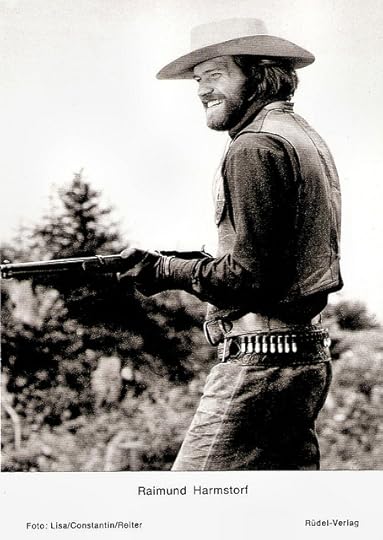
German postcard by Rüdel-Verlag, Hamburg, no. 5340. Photo: Lisa / Constantin / Reiter. Publicity still for Der Schrei der schwarzen Wölfe/Cry of the Black Wolves (Harald Reinl, 1972).
Jack London and Jules Verne
Raimund Harmstorf was born in Hamburg, Germany in 1939. He was the son of a doctor.
Harmstorf started a sports career and specialized in the decathlon. He then studied medicine, and later studied music and performing arts at the Staatlichen Hochschule für Musik und darstellende Kunst in Hamburg.
From the mid-1960s on, he performed in small parts in TV productions. One of his first films was Siegfried und das sagenhafte Liebesleben der Nibelungen/Maidenhead ( Adrian Hoven , David F. Friedman, 1971), an ‘adults only’ retelling of the legend of Siegfried in which he was credited as Lance Boyle.
He had his breakthrough as the evil-minded Captain Larsen in the TV series Der Seewolf/The Sea Wolf (Wolfgang Staudte, a.o., 1971), based on Jack London's novel. The series made him very popular among TV audiences, especially with the ladies.
He then acted in two more Jack London adaptations, Ruf der Wildnis/The Call of the Wild (Ken Annakin, 1972) with Charlton Heston and Der Schrei der schwarzen Wölfe/Cry of the Black Wolves (Harald Reinl, 1972) with Ron Ely.
In Italy he appeared in the adventure film Zanna Bianca/White Fang (Lucio Fulci, 1973), starring Franco Nero . It was another telling of Jack London's tale of a prospector and his loyal sled dog as they battle avaricious villains during their search for gold.
The film gained a great commercial success and generated the official sequel Il ritorno di Zanna Bianca/Challenge to White Fang (Lucio Fulci, 1973) with the same cast, and several non-official sequels.
Later Harmstorf co-starred with Terence Hill and Miou-Miou in the comic Spaghetti-Western Un genio, due compari, un pollo/A Genius, Two Partners and a Dupe (Damiano Damiani, 1975). The opening scene was directed by Sergio Leone, who also produced the film. It was the last Western that Leone worked on. He was disappointed in the final outcome and chose to remain uncredited. Thanks to the popularity of Terence Hill , the film was quite successful at the European box office. However, it was very negatively received by critics, and has not gained a higher reputation over time.
Harmstorf then starred in another very popular TV series, Michael Strogoff: Der Kurier des Zaren/Michel Strogoff (Jean-Pierre Decourt, 1975), based on Jules Verne's classic adventure novel. He was unforgettable as the handsome hero with a secret mission in an old Russia threatened by Kozaks and frozen rivers, wearing woolly hats and serious faces.
Harmstorf returned to Italy to co-star with Giuliano Gemma in another Spaghetti Western, California Addio/California (Michele Lupo, 1977) which was generally well received by critics and a success at the Italian box office.
The following year, he had a supporting part in the WWII action Quel maledetto treno blindato/The Inglorious Bastards (Enzo G. Castellari, 1978), starring Fred Williamson and Bo Svenson, which was remade by Quentin Tarantino in 2009.
Harmstorf co-starred with Bud Spencer in the action comedy Lo chiamavano Bulldozer/They Call Him Bulldozer (Michele Lupo, 1978). He followed it with another Bud Spencer vehicle, Uno sceriffo extraterrestre - poco extra e molto terrestre/The Sheriff and the Satellite Kid (Michele Lupo, 1979).
Vintage postcard. Photo: publicity still for Michel Strogoff/Michael Strogoff (Jean-Pierre Decourt, 1975).
Suicide and Media Scandal
In the 1980’s, the film career of Raimund Harmstorf halted.
He appeared in the French film L'empreinte des géants/The Imprint of Giants (Robert Enrico, 1980) with Serge Reggiani .
In 1983, he co-starred in the French-German spy-film S.A.S. à San Salvador (Raul Coutard, 1983) based on one of the 175 popular spy novels by Gérard de Villiers. Former Tarzan Miles O'Keeffe starred as Malko, am Austrian count in need of cash on a CIA mission. The film failed at the box office.
In Germany, Harmstorf often appeared in TV series, like the Krimi Der Alte/The Old Fox (1982-1983). He also appeared in some minor German and Italian features, like the crime drama Thunder (Fabrizio De Angelis, 1983) with Bo Svenson.
South Africa was the location for the Canadian TV series African Skies (1991–1994), in which he co-starred with Catherine Bach and Robert Mitchum.
For one of his last films, The Wolves (Steve Carver, 1995), he returned to the Alaskan wilderness, once again playing the bad guy.
The end of Harmstorf’s life was full of tragedies. His fish restaurant Zum Seewolf in Bad Durkheim went bankrupt, he was affected by Parkinson's disease and he became weakened by a regimen of heavy medication.
His illness and vulnerability were exploited by the tabloids. In 1998 he committed suicide by hanging himself in his home in Marktoberdorf, Germany.
His death caused a scandal and German tabloids were investigated. German police consequently stated that Harmstorf's suicide had been substantially promoted by certain articles. In particular Bild was blamed because it had already published Harmstorf's suicide on its main page before his actual death.
Raimund Harmstorf was 58.
German trailer for Der Seewolf/The Sea Wolf (Wolfgang Staudte, a.o., 1971). Source: HHMaster92 (YouTube).
Trailer California Addio/California (Michele Lupo, 1977). Source: The Spaghetti Western Database (YouTube).
Sources: Stephanie d’Heil (Steffie-line) (German), Tom B. (Westerns All’Italiana), Wikipedia, and .

German postcard by Rüdel-Verlag, Hamburg, no. 5340. Photo: Lisa / Constantin / Reiter. Publicity still for Der Schrei der schwarzen Wölfe/Cry of the Black Wolves (Harald Reinl, 1972).
Jack London and Jules Verne
Raimund Harmstorf was born in Hamburg, Germany in 1939. He was the son of a doctor.
Harmstorf started a sports career and specialized in the decathlon. He then studied medicine, and later studied music and performing arts at the Staatlichen Hochschule für Musik und darstellende Kunst in Hamburg.
From the mid-1960s on, he performed in small parts in TV productions. One of his first films was Siegfried und das sagenhafte Liebesleben der Nibelungen/Maidenhead ( Adrian Hoven , David F. Friedman, 1971), an ‘adults only’ retelling of the legend of Siegfried in which he was credited as Lance Boyle.
He had his breakthrough as the evil-minded Captain Larsen in the TV series Der Seewolf/The Sea Wolf (Wolfgang Staudte, a.o., 1971), based on Jack London's novel. The series made him very popular among TV audiences, especially with the ladies.
He then acted in two more Jack London adaptations, Ruf der Wildnis/The Call of the Wild (Ken Annakin, 1972) with Charlton Heston and Der Schrei der schwarzen Wölfe/Cry of the Black Wolves (Harald Reinl, 1972) with Ron Ely.
In Italy he appeared in the adventure film Zanna Bianca/White Fang (Lucio Fulci, 1973), starring Franco Nero . It was another telling of Jack London's tale of a prospector and his loyal sled dog as they battle avaricious villains during their search for gold.
The film gained a great commercial success and generated the official sequel Il ritorno di Zanna Bianca/Challenge to White Fang (Lucio Fulci, 1973) with the same cast, and several non-official sequels.
Later Harmstorf co-starred with Terence Hill and Miou-Miou in the comic Spaghetti-Western Un genio, due compari, un pollo/A Genius, Two Partners and a Dupe (Damiano Damiani, 1975). The opening scene was directed by Sergio Leone, who also produced the film. It was the last Western that Leone worked on. He was disappointed in the final outcome and chose to remain uncredited. Thanks to the popularity of Terence Hill , the film was quite successful at the European box office. However, it was very negatively received by critics, and has not gained a higher reputation over time.
Harmstorf then starred in another very popular TV series, Michael Strogoff: Der Kurier des Zaren/Michel Strogoff (Jean-Pierre Decourt, 1975), based on Jules Verne's classic adventure novel. He was unforgettable as the handsome hero with a secret mission in an old Russia threatened by Kozaks and frozen rivers, wearing woolly hats and serious faces.
Harmstorf returned to Italy to co-star with Giuliano Gemma in another Spaghetti Western, California Addio/California (Michele Lupo, 1977) which was generally well received by critics and a success at the Italian box office.
The following year, he had a supporting part in the WWII action Quel maledetto treno blindato/The Inglorious Bastards (Enzo G. Castellari, 1978), starring Fred Williamson and Bo Svenson, which was remade by Quentin Tarantino in 2009.
Harmstorf co-starred with Bud Spencer in the action comedy Lo chiamavano Bulldozer/They Call Him Bulldozer (Michele Lupo, 1978). He followed it with another Bud Spencer vehicle, Uno sceriffo extraterrestre - poco extra e molto terrestre/The Sheriff and the Satellite Kid (Michele Lupo, 1979).
Vintage postcard. Photo: publicity still for Michel Strogoff/Michael Strogoff (Jean-Pierre Decourt, 1975).
Suicide and Media Scandal
In the 1980’s, the film career of Raimund Harmstorf halted.
He appeared in the French film L'empreinte des géants/The Imprint of Giants (Robert Enrico, 1980) with Serge Reggiani .
In 1983, he co-starred in the French-German spy-film S.A.S. à San Salvador (Raul Coutard, 1983) based on one of the 175 popular spy novels by Gérard de Villiers. Former Tarzan Miles O'Keeffe starred as Malko, am Austrian count in need of cash on a CIA mission. The film failed at the box office.
In Germany, Harmstorf often appeared in TV series, like the Krimi Der Alte/The Old Fox (1982-1983). He also appeared in some minor German and Italian features, like the crime drama Thunder (Fabrizio De Angelis, 1983) with Bo Svenson.
South Africa was the location for the Canadian TV series African Skies (1991–1994), in which he co-starred with Catherine Bach and Robert Mitchum.
For one of his last films, The Wolves (Steve Carver, 1995), he returned to the Alaskan wilderness, once again playing the bad guy.
The end of Harmstorf’s life was full of tragedies. His fish restaurant Zum Seewolf in Bad Durkheim went bankrupt, he was affected by Parkinson's disease and he became weakened by a regimen of heavy medication.
His illness and vulnerability were exploited by the tabloids. In 1998 he committed suicide by hanging himself in his home in Marktoberdorf, Germany.
His death caused a scandal and German tabloids were investigated. German police consequently stated that Harmstorf's suicide had been substantially promoted by certain articles. In particular Bild was blamed because it had already published Harmstorf's suicide on its main page before his actual death.
Raimund Harmstorf was 58.
German trailer for Der Seewolf/The Sea Wolf (Wolfgang Staudte, a.o., 1971). Source: HHMaster92 (YouTube).
Trailer California Addio/California (Michele Lupo, 1977). Source: The Spaghetti Western Database (YouTube).
Sources: Stephanie d’Heil (Steffie-line) (German), Tom B. (Westerns All’Italiana), Wikipedia, and .
Published on March 29, 2014 23:00
Cifesa
Some years ago, I found at a flea market in Southern Spain these collectors cards from the 1930s and 1940s. I liked the hand-coloured or painted images of the American, French and German stars of the era, but especially the ones of the Spanish actors, who were mostly unknown to me. These thin cards are all printed by the firm of I.G. Vilado in Barcelona and most of them also contain a large sign, Cifesa. I did a little research in this terra incognita.
Cifesa was the most important Spanish film production company and film distributor of the Franco era, and the only one that attempted to function as a traditional Hollywood studio. Among the stars of the studio were Luis Pena, Sara Montiel, Fernando Rey, Jorge Mistral and the immensely popular Imperio Argentina. Cifesa sponsored lavish public premieres for selected films, and created these star cards.
Sara Montiel . Spanish collectors card by I.G. Viladot, Barcelona. Image: Cifesa.
Florencia Becquer. Spanish collectors card by I.G. Viladot, Barcelona. Image: Cifesa.
Maria Mercader. Spanish collectors card by I.G. Viladot, Barcelona. Image: Cifesa.
The Torch of Hits
Cifesa, anacronym for Compania Industrial Film Espanola, was founded by Vicente Trenor in Valencia in 1932.
Soon it was soon taken over by an olive oil industrialist, Vicente Casanova, whose son had shown interest in the cinema. From 1933, the company turned out a series of well-crafted, expensive costume pictures and musicals directed by established figures like Benito Perojo and Florián Rey, and acquired a solid reputation among audiences.
Cifesa's motto was ‘The torch of hits’; creating a logo and a house style, as well as nurturing a compact group of stars, was an important lesson Casanova learned from Hollywood.
Ideologically, the Casanova family were conservative Republicans, but after the Civil War, the company pledged allegiance to the Franco regime. This was a perfect collaboration, as the studio was used for propaganda purposes and benefited from a series of privileges.
From 1942 on, against a background of absolute poverty in a country that would take two decades to recover from the conflict, Casanova was back in business producing a series of war films, melodramas, and comedies that created their own version of reality and refused to engage with social issues.
The studio-like aspects of the company were reinforced: soundstages and a company of actors (for instance Amparo Rivelles, Alfredo Mayo, and, later, Aurora Bautista) and technicians, and a certain consistency in tone and approaches due to the presence of strong directors (like Juan de Orduña and José Luis Sáenz de Heredia) who undertook their projects following general programs and guidelines and the firm grip of head of production Luis Lucia.
The general production standards were as high as the times allowed, but the emphasis was on high turnout rather than expensive individual films.
David Niven . Spanish collectors card by I.G. Viladot, Barcelona. Image: Cifesa.
Rossano Brazzi. Spanish collectors card by I.G. Viladot, Barcelona. Image: Cifesa.
Willi Forst . Spanish collectors card by I.G. Viladot, Barcelona. Image: Cifesa.
Holding up the regime's conservative values
The end of World War II was a blow to the Franco government, which was plunged into a situation of complete isolation as the last remnant in Europe of Fascist ideologies. But rather than compromise and benefit from the reconstruction measures introduced by the Allies, the regime decided to strengthen conservatism.
The crisis this led to was reflected in the film business. The government redesigned the system of funding cultural expression - as long as it was the 'right' one. An important aspect was the introduction of a category of special support to those films that could uphold the regime's conservative values.
Casanova responded with a series of lavish historical epics. The company's strategy shifted now to focus on a small number of expensive pictures every year, which would not only be awarded 'special interest' funding, but could also turn good profits at the box office.
In the beginning, the strategy seemed to work, with Locura de amor/Mad for Love (Juan De Orduña, 1948) and, later, Agustina de Aragón (Juan de Orduña, 1950), quickly becoming box-office hits.
But investment in each picture was so high that disappointing box-office takings could easily have an impact on the company's finances. This is exactly what happened with La leona de castilla/Lioness of Castille (Juan de Orduña, 1951).
When one of Cifesa's most expensive production efforts, an epic about Christopher Columbus' first expedition titled Alba de América/Dawn of America (Juan de Orduña, 1951), failed to get special interest funding because politicians decided to support José Antonio Nieves Conde's realistic Surcos/Burrows (1951) instead; and when the film only did average business, the company was back in the red, and this time it was unable to regain its previous prowess.
By 1952, the financial crisis deepened, and after a run of poor films, Cifesa disappeared as a film production company in 1956. As a distributor Cifesa remained active till 1964.
Jean Harlow. Spanish collectors card by I.G. Viladot, Barcelona. Photo: Metro-Goldwyn Mayer. Cifesa was perhaps
Hilde Krahl . Spanish collectors card by I.G. Viladot, Barcelona. Image: Cifesa.
Viviane Romance . Spanish collectors card by I.G. Viladot, Barcelona. Image: Cifesa.
Sources: Alberto Mira (Historical Dictionary of Spanish Cinema), A Companion to Spanish Cinema, Spanish popular cinema, 100 Years of Spanish Cinema, Wikipedia (Spanish and English) and IMDb.
Cifesa was the most important Spanish film production company and film distributor of the Franco era, and the only one that attempted to function as a traditional Hollywood studio. Among the stars of the studio were Luis Pena, Sara Montiel, Fernando Rey, Jorge Mistral and the immensely popular Imperio Argentina. Cifesa sponsored lavish public premieres for selected films, and created these star cards.
Sara Montiel . Spanish collectors card by I.G. Viladot, Barcelona. Image: Cifesa.
Florencia Becquer. Spanish collectors card by I.G. Viladot, Barcelona. Image: Cifesa.
Maria Mercader. Spanish collectors card by I.G. Viladot, Barcelona. Image: Cifesa.
The Torch of Hits
Cifesa, anacronym for Compania Industrial Film Espanola, was founded by Vicente Trenor in Valencia in 1932.
Soon it was soon taken over by an olive oil industrialist, Vicente Casanova, whose son had shown interest in the cinema. From 1933, the company turned out a series of well-crafted, expensive costume pictures and musicals directed by established figures like Benito Perojo and Florián Rey, and acquired a solid reputation among audiences.
Cifesa's motto was ‘The torch of hits’; creating a logo and a house style, as well as nurturing a compact group of stars, was an important lesson Casanova learned from Hollywood.
Ideologically, the Casanova family were conservative Republicans, but after the Civil War, the company pledged allegiance to the Franco regime. This was a perfect collaboration, as the studio was used for propaganda purposes and benefited from a series of privileges.
From 1942 on, against a background of absolute poverty in a country that would take two decades to recover from the conflict, Casanova was back in business producing a series of war films, melodramas, and comedies that created their own version of reality and refused to engage with social issues.
The studio-like aspects of the company were reinforced: soundstages and a company of actors (for instance Amparo Rivelles, Alfredo Mayo, and, later, Aurora Bautista) and technicians, and a certain consistency in tone and approaches due to the presence of strong directors (like Juan de Orduña and José Luis Sáenz de Heredia) who undertook their projects following general programs and guidelines and the firm grip of head of production Luis Lucia.
The general production standards were as high as the times allowed, but the emphasis was on high turnout rather than expensive individual films.
David Niven . Spanish collectors card by I.G. Viladot, Barcelona. Image: Cifesa.
Rossano Brazzi. Spanish collectors card by I.G. Viladot, Barcelona. Image: Cifesa.
Willi Forst . Spanish collectors card by I.G. Viladot, Barcelona. Image: Cifesa.
Holding up the regime's conservative values
The end of World War II was a blow to the Franco government, which was plunged into a situation of complete isolation as the last remnant in Europe of Fascist ideologies. But rather than compromise and benefit from the reconstruction measures introduced by the Allies, the regime decided to strengthen conservatism.
The crisis this led to was reflected in the film business. The government redesigned the system of funding cultural expression - as long as it was the 'right' one. An important aspect was the introduction of a category of special support to those films that could uphold the regime's conservative values.
Casanova responded with a series of lavish historical epics. The company's strategy shifted now to focus on a small number of expensive pictures every year, which would not only be awarded 'special interest' funding, but could also turn good profits at the box office.
In the beginning, the strategy seemed to work, with Locura de amor/Mad for Love (Juan De Orduña, 1948) and, later, Agustina de Aragón (Juan de Orduña, 1950), quickly becoming box-office hits.
But investment in each picture was so high that disappointing box-office takings could easily have an impact on the company's finances. This is exactly what happened with La leona de castilla/Lioness of Castille (Juan de Orduña, 1951).
When one of Cifesa's most expensive production efforts, an epic about Christopher Columbus' first expedition titled Alba de América/Dawn of America (Juan de Orduña, 1951), failed to get special interest funding because politicians decided to support José Antonio Nieves Conde's realistic Surcos/Burrows (1951) instead; and when the film only did average business, the company was back in the red, and this time it was unable to regain its previous prowess.
By 1952, the financial crisis deepened, and after a run of poor films, Cifesa disappeared as a film production company in 1956. As a distributor Cifesa remained active till 1964.
Jean Harlow. Spanish collectors card by I.G. Viladot, Barcelona. Photo: Metro-Goldwyn Mayer. Cifesa was perhaps
Hilde Krahl . Spanish collectors card by I.G. Viladot, Barcelona. Image: Cifesa.
Viviane Romance . Spanish collectors card by I.G. Viladot, Barcelona. Image: Cifesa.
Sources: Alberto Mira (Historical Dictionary of Spanish Cinema), A Companion to Spanish Cinema, Spanish popular cinema, 100 Years of Spanish Cinema, Wikipedia (Spanish and English) and IMDb.
Published on March 29, 2014 00:00
Paul van Yperen's Blog
- Paul van Yperen's profile
- 13 followers
Paul van Yperen isn't a Goodreads Author
(yet),
but they
do have a blog,
so here are some recent posts imported from
their feed.



